2015 AMC 10/12 A Discussion
Go back to the Math Jam ArchiveA discussion of problems from the AMC 10/12 A, which is administered February 3. We will cover the last 5 problems on each test, as well as requested earlier problems on the tests.
Copyright © 2025 AoPS Incorporated. This page is copyrighted material. You can view and print this page for your own use, but you cannot share the contents of this file with others.
Facilitator: Jeremy Copeland
copeland
2015-02-04 18:50:37
The Math Jam will start at 7:00 PM Eastern / 4:00 PM Pacific.
The Math Jam will start at 7:00 PM Eastern / 4:00 PM Pacific.
copeland
2015-02-04 18:50:39
The classroom is moderated, meaning that you can type into the classroom, but these comments will not go directly into the room.
The classroom is moderated, meaning that you can type into the classroom, but these comments will not go directly into the room.
copeland
2015-02-04 18:50:41
Please do not ask about administrative aspects of the contests, and please do not ask me to speculate about the results.
Please do not ask about administrative aspects of the contests, and please do not ask me to speculate about the results.
mathmaster2000
2015-02-04 18:52:10
Hello
Hello
stuff1014
2015-02-04 18:52:10
hi
hi
Onomatopoeia
2015-02-04 18:52:10
hello
hello
mathwrath
2015-02-04 18:52:10
Hello
Hello
SirCalcsALot
2015-02-04 18:52:10
Hello copeland
Hello copeland
chococheese15
2015-02-04 18:52:10
hi
hi
droid347
2015-02-04 18:52:10
Hello!
Hello!
chococheese15
2015-02-04 18:52:10
hi
hi
copeland
2015-02-04 18:52:11
Hi everybody.
Hi everybody.
masad24
2015-02-04 18:52:39
hi c:
hi c:
dragonfly
2015-02-04 18:52:39
hi
hi
bluehall90
2015-02-04 18:52:39
Hiii
Hiii
SVstudent2013
2015-02-04 18:52:39
hi
hi
PingThePanda
2015-02-04 18:52:39
hi
hi
DeathLlama9
2015-02-04 18:52:39
Hi Mr. Copeland!
Hi Mr. Copeland!
brian22
2015-02-04 18:52:39
Hi.
Hi.
hesa57
2015-02-04 18:52:59
I cannot join right now; when can I see the transcript?
I cannot join right now; when can I see the transcript?
copeland
2015-02-04 18:53:01
The transcript will be available soon after the Math Jam.
The transcript will be available soon after the Math Jam.
droid347
2015-02-04 18:53:44
Mr. Copeland, did you think this AMC 10 was way more "troll" than other AMC 10s?
Mr. Copeland, did you think this AMC 10 was way more "troll" than other AMC 10s?
copeland
2015-02-04 18:53:45
Troll, huh? I saw the word "trolly" on the site and thought 'ding-ding!'
Troll, huh? I saw the word "trolly" on the site and thought 'ding-ding!'
brian22
2015-02-04 18:54:07
soon after can range from a few hours to a few days
soon after can range from a few hours to a few days
copeland
2015-02-04 18:54:08
By tomorrow morning, PT.
By tomorrow morning, PT.
brian22
2015-02-04 18:54:29
lol it's spelled trolley I thiink
lol it's spelled trolley I thiink
copeland
2015-02-04 18:54:33
Yeah. . .
Yeah. . .
SimonSun
2015-02-04 18:54:59
do you think they will make the achievement role requiment higher?
do you think they will make the achievement role requiment higher?
copeland
2015-02-04 18:55:00
I won't speculate on what the AMC will do with the scores.
I won't speculate on what the AMC will do with the scores.
xantho
2015-02-04 18:55:39
Do the moderators have any know-how of whats holding back the 10A answers?
Do the moderators have any know-how of whats holding back the 10A answers?
copeland
2015-02-04 18:55:40
My theory is Problem 20.
My theory is Problem 20.
ralph4imo
2015-02-04 18:56:10
Mr. Copeland, can we discuss problems outside the final five? (14 in particular)
Mr. Copeland, can we discuss problems outside the final five? (14 in particular)
copeland
2015-02-04 18:56:11
We will probably only discuss the last 5, with a note on a couple others.
We will probably only discuss the last 5, with a note on a couple others.
IequalSmart
2015-02-04 18:56:52
I feel like we are the press, asking you all our questions. lol
I feel like we are the press, asking you all our questions. lol
copeland
2015-02-04 18:56:53
I feel like the President, or maybe Madonna.
I feel like the President, or maybe Madonna.
1023ong
2015-02-04 18:57:08
what's the schedule for tonight? shared problems first or amc 10 first or what?
what's the schedule for tonight? shared problems first or amc 10 first or what?
copeland
2015-02-04 18:57:10
I'll explain the schedule when we get started.
I'll explain the schedule when we get started.
JOHNSUNG
2015-02-04 18:57:46
How long will the math jam last?
How long will the math jam last?
champion999
2015-02-04 18:57:46
How long will this Math Jam be?
How long will this Math Jam be?
copeland
2015-02-04 18:57:47
Probably around 3 hours.
Probably around 3 hours.
TheMaskedMagician
2015-02-04 18:58:20
Will Mr. Rusczyk be making videos for the final 5 this year?
Will Mr. Rusczyk be making videos for the final 5 this year?
copeland
2015-02-04 18:58:22
Yes!
Yes!
copeland
2015-02-04 18:58:30
I'll post a link at the end of the session.
I'll post a link at the end of the session.
mathawesomeness777
2015-02-04 18:59:05
Has MAA posted the AMC 10 Answers?
Has MAA posted the AMC 10 Answers?
copeland
2015-02-04 18:59:06
They hadn't 20 minutes ago. I don't know when those will go up.
They hadn't 20 minutes ago. I don't know when those will go up.
AoPSNovice314
2015-02-04 18:59:54
Just a fun question before the math jam starts, what is your favorite number Mr. Copeland?
Just a fun question before the math jam starts, what is your favorite number Mr. Copeland?
copeland
2015-02-04 18:59:55
225.
225.
liant
2015-02-04 19:00:26
why
why
imath2013
2015-02-04 19:00:26
why?
why?
miloszeman
2015-02-04 19:00:26
Why?
Why?
zmyshatlp
2015-02-04 19:00:26
Why?
Why?
liant
2015-02-04 19:00:26
Why
Why
gradysocool
2015-02-04 19:00:26
Why 225?
Why 225?
bharatputra
2015-02-04 19:00:26
why is it your favorite number
why is it your favorite number
mango99
2015-02-04 19:00:26
why?
why?
sarvottam
2015-02-04 19:00:26
15^2
15^2
myungsooglee
2015-02-04 19:00:26
why?
why?
jrexmo
2015-02-04 19:00:26
Any reason?
Any reason?
5cmpersun
2015-02-04 19:00:26
why?
why?
copeland
2015-02-04 19:00:32
Weird. I never thought about why. . .
Weird. I never thought about why. . .
DeathLlama9
2015-02-04 19:00:42
What is your least favorite number?
What is your least favorite number?
copeland
2015-02-04 19:00:43
3665.
3665.
copeland
2015-02-04 19:00:59
Should we get started?
Should we get started?
Kiola
2015-02-04 19:01:16
Yessssss
Yessssss
atmchallenge
2015-02-04 19:01:16
yes
yes
kwausouq
2015-02-04 19:01:16
Yea
Yea
RoboMan
2015-02-04 19:01:16
sure!
sure!
liant
2015-02-04 19:01:16
idk
idk
goodbear
2015-02-04 19:01:16
yes.
yes.
copeland
2015-02-04 19:01:19
Welcome to the 2014 AMC 10A/12A Math Jam!
Welcome to the 2014 AMC 10A/12A Math Jam!
copeland
2015-02-04 19:01:20
I'm Jeremy Copeland, and I'll be leading our discussion tonight.
I'm Jeremy Copeland, and I'll be leading our discussion tonight.
copeland
2015-02-04 19:01:23
I'm the school director here at AoPS. That means when something goes wrong, I either get yelled at or have to yell at someone else. Before AoPS, I was an instructor at MIT, and before that I got my Ph.D. from the University of Chicago. Before that I was an undergrad at Reed College and going back even further, I can't really remember. I used to have hobbies, but I'm a parent now, so those days are all over.
I'm the school director here at AoPS. That means when something goes wrong, I either get yelled at or have to yell at someone else. Before AoPS, I was an instructor at MIT, and before that I got my Ph.D. from the University of Chicago. Before that I was an undergrad at Reed College and going back even further, I can't really remember. I used to have hobbies, but I'm a parent now, so those days are all over.
copeland
2015-02-04 19:01:33
Before we get started I would like to take a moment to explain our virtual classroom procedures to those who have not previously participated in a Math Jam or one of our online classes.
Before we get started I would like to take a moment to explain our virtual classroom procedures to those who have not previously participated in a Math Jam or one of our online classes.
copeland
2015-02-04 19:01:36
The classroom is moderated, meaning that students can type into the classroom, but these comments will not go directly into the room. These comments go to the instructors, who may choose to share your comments with the room.
The classroom is moderated, meaning that students can type into the classroom, but these comments will not go directly into the room. These comments go to the instructors, who may choose to share your comments with the room.
mathawesomeness777
2015-02-04 19:01:49
How do you type so fast?
How do you type so fast?
copeland
2015-02-04 19:01:50
I have 2 keyboards.
I have 2 keyboards.
copeland
2015-02-04 19:01:56
Moderation helps keep the class organized and on track. This also means that only well-written comments will be dropped into the classroom, so please take time writing responses that are complete and easy to read.
Moderation helps keep the class organized and on track. This also means that only well-written comments will be dropped into the classroom, so please take time writing responses that are complete and easy to read.
copeland
2015-02-04 19:02:00
There are a ton of students here! (Actually a lot closer to 50 tons, which is fewer tonnes, and only around 35 tuns.) As I said, only a fraction of the well-written comments will be passed to the entire group. Please do not take it personally if your comments do not get posted, and please do not complain about it. I expect this Math Jam to be much larger than our typical class, so please be patient with me---there are quite a few of you here tonight!!
There are a ton of students here! (Actually a lot closer to 50 tons, which is fewer tonnes, and only around 35 tuns.) As I said, only a fraction of the well-written comments will be passed to the entire group. Please do not take it personally if your comments do not get posted, and please do not complain about it. I expect this Math Jam to be much larger than our typical class, so please be patient with me---there are quite a few of you here tonight!!
copeland
2015-02-04 19:02:11
Also, we won't be going through the math quite as thoroughly as we do in our classes -- I can't teach all the prerequisite material for every problem as we go. Another difference between tonight and our regular online classes is that it is very unlikely that we'll be able to answer every single question you ask. We usually do in our classes, but we have a large number of students tonight! So, please go ahead and ask questions, but also please understand if we aren't able to answer them all!
Also, we won't be going through the math quite as thoroughly as we do in our classes -- I can't teach all the prerequisite material for every problem as we go. Another difference between tonight and our regular online classes is that it is very unlikely that we'll be able to answer every single question you ask. We usually do in our classes, but we have a large number of students tonight! So, please go ahead and ask questions, but also please understand if we aren't able to answer them all!
copeland
2015-02-04 19:02:29
We have 3 assistants tonight: Alina Kononov (laughinghead505), Benjamin Engwall (bluecarneal), and Jackie Brendenberg (3628800J).
We have 3 assistants tonight: Alina Kononov (laughinghead505), Benjamin Engwall (bluecarneal), and Jackie Brendenberg (3628800J).
copeland
2015-02-04 19:02:32
Alina joined AoPS in 2006 as a young, impressionable mathematician. She is an alumna of MathPath, Canada/USA Mathcamp, the Illinois Math and Science Academy, and MIT. Currently, she is a graduate student in physics at the University of Illinois at Urbana-Champaign. In her scraps of free time, Alina enjoys eating and making sweets, reading science fiction, crafting, and exploring urban areas.
Alina joined AoPS in 2006 as a young, impressionable mathematician. She is an alumna of MathPath, Canada/USA Mathcamp, the Illinois Math and Science Academy, and MIT. Currently, she is a graduate student in physics at the University of Illinois at Urbana-Champaign. In her scraps of free time, Alina enjoys eating and making sweets, reading science fiction, crafting, and exploring urban areas.
copeland
2015-02-04 19:02:34
Benjamin is currently participating in Georgia Tech's Online Masters program for Computer Science - one of his favorite subjects. He has been an active member of the AoPS community since 2008, and thoroughly enjoys the opportunity he has to be a Grader and TA. In his spare time, he enjoys swimming competitively, reading, and pretending he can golf.
Benjamin is currently participating in Georgia Tech's Online Masters program for Computer Science - one of his favorite subjects. He has been an active member of the AoPS community since 2008, and thoroughly enjoys the opportunity he has to be a Grader and TA. In his spare time, he enjoys swimming competitively, reading, and pretending he can golf.
copeland
2015-02-04 19:02:43
Jackie lives in Michigan, where she won the statewide Michigan Math Prize Competition. She was also a 3-time USA(J)MO qualifier and a member of the USA team at the International Linguistics Olympiad. She plans to major in math and computer science. In her free time, she enjoys cooking, running cross country, and solving crossword puzzles.
Jackie lives in Michigan, where she won the statewide Michigan Math Prize Competition. She was also a 3-time USA(J)MO qualifier and a member of the USA team at the International Linguistics Olympiad. She plans to major in math and computer science. In her free time, she enjoys cooking, running cross country, and solving crossword puzzles.
laughinghead505
2015-02-04 19:02:54
Hi everyone!
Hi everyone!
bluecarneal
2015-02-04 19:02:57
Hello!
Hello!
3628800J
2015-02-04 19:02:58
Hello!
Hello!
ralph4imo
2015-02-04 19:03:23
Hello!
Hello!
geogirl08
2015-02-04 19:03:23
hi
hi
zew
2015-02-04 19:03:23
hi!
hi!
SimonSun
2015-02-04 19:03:23
hi!!!!!!!!!
hi!!!!!!!!!
math0127
2015-02-04 19:03:23
hi! thanks for being here!
hi! thanks for being here!
winnertakeover
2015-02-04 19:03:23
hi
hi
Art123
2015-02-04 19:03:23
Hi!
Hi!
kunsun
2015-02-04 19:03:23
hi
hi
zmyshatlp
2015-02-04 19:03:23
Hello!
Hello!
copeland
2015-02-04 19:03:26
They can answer questions by whispering to you or by opening a window with you to chat 1-on-1. However, due to the incredibly large size of the session tonight, they may not be able to get to you right away (or at all). Repeating your question over and over is more likely to annoy us than to get it answered faster, so please, just ask your question once and be patient, and please understand that we may not be able to answer all the questions tonight.
They can answer questions by whispering to you or by opening a window with you to chat 1-on-1. However, due to the incredibly large size of the session tonight, they may not be able to get to you right away (or at all). Repeating your question over and over is more likely to annoy us than to get it answered faster, so please, just ask your question once and be patient, and please understand that we may not be able to answer all the questions tonight.
Bob_Smith
2015-02-04 19:03:37
what about v_Enhance?
what about v_Enhance?
copeland
2015-02-04 19:03:38
I see him! He's just here for fun I think.
I see him! He's just here for fun I think.
copeland
2015-02-04 19:03:42
Please also remember that the purpose of this Math Jam is to work through the solutions to AMC problems, and not to merely present the answers. "Working through the solutions" includes discussing problem-solving tactics. So please, when a question is posted, do not simply respond with the final answer. That's not why we're here. We're going to work through the problems step-by-step, and comments that skip key steps or jump ahead in the problem, without providing explanation or motivation, won't be posted.
Please also remember that the purpose of this Math Jam is to work through the solutions to AMC problems, and not to merely present the answers. "Working through the solutions" includes discussing problem-solving tactics. So please, when a question is posted, do not simply respond with the final answer. That's not why we're here. We're going to work through the problems step-by-step, and comments that skip key steps or jump ahead in the problem, without providing explanation or motivation, won't be posted.
copeland
2015-02-04 19:03:47
Also notice that there will be several cases where we actually find the answer or almost the answer but instead wander off. The goal is always to find a proof that our answer is correct and not just find the answers. Of course on the AMC you should aim to do much less work than this.
Also notice that there will be several cases where we actually find the answer or almost the answer but instead wander off. The goal is always to find a proof that our answer is correct and not just find the answers. Of course on the AMC you should aim to do much less work than this.
copeland
2015-02-04 19:04:02
We will work the last 5 problems from the AMC 10A, then the last 5 problems from the AMC 12A. Two of these problems are the same, 10A Problem 25 and 12A Problem 23. We'll only solve that problem once.
We will work the last 5 problems from the AMC 10A, then the last 5 problems from the AMC 12A. Two of these problems are the same, 10A Problem 25 and 12A Problem 23. We'll only solve that problem once.
copeland
2015-02-04 19:04:12
We usually promise to chat about other problems on the test, but honestly, I tend to meander and most of us will be exhausted by the end of these 9 problems.
We usually promise to chat about other problems on the test, but honestly, I tend to meander and most of us will be exhausted by the end of these 9 problems.
copeland
2015-02-04 19:04:18
Let's get started!
Let's get started!
thatindiankid10
2015-02-04 19:04:45
Yay!
Yay!
stuff1014
2015-02-04 19:04:45
ok
ok
jerryfu
2015-02-04 19:04:45
Lets a go!
Lets a go!
hibiscus
2015-02-04 19:04:45
Yahoo!
Yahoo!
prpaxson
2015-02-04 19:04:45
Yay!
Yay!
katmcphie
2015-02-04 19:04:45
yay!
yay!
mishka1980
2015-02-04 19:04:45
Yay!
Yay!
copeland
2015-02-04 19:04:52
Oh, and there truly are a lot of people here tonight. I really don't like saying it, but we're probably going to miss some of the things that some of you say. (Especially during the geometry problems - sheesh.) Please forgive me in advance. That doesn't happen in our classes.
Oh, and there truly are a lot of people here tonight. I really don't like saying it, but we're probably going to miss some of the things that some of you say. (Especially during the geometry problems - sheesh.) Please forgive me in advance. That doesn't happen in our classes.
copeland
2015-02-04 19:04:58
Let's start with the most interesting problem on the exam. This problem was on both exams:
Let's start with the most interesting problem on the exam. This problem was on both exams:
copeland
2015-02-04 19:04:59
AMC 10 Problem 5/AMC12 Problem 3. Mr. Patrick teaches math to 15 students. He was grading tests and found that when he graded everyone's test except Payton's, the average grade for the class was 80. After he graded Payton's test, the class average became 81. What was Payton's score on the test?
peekaboo!
(A) 81(B) 85(C) 91(D) 94(E) 95
AMC 10 Problem 5/AMC12 Problem 3. Mr. Patrick teaches math to 15 students. He was grading tests and found that when he graded everyone's test except Payton's, the average grade for the class was 80. After he graded Payton's test, the class average became 81. What was Payton's score on the test?
peekaboo!
(A) 81(B) 85(C) 91(D) 94(E) 95
flyrain
2015-02-04 19:05:32
it was e
it was e
yingzesen
2015-02-04 19:05:32
e
e
hibiscus
2015-02-04 19:05:32
E
E
ralph4imo
2015-02-04 19:05:32
95 E
95 E
Ultimate_draco
2015-02-04 19:05:32
E
E
yingzesen
2015-02-04 19:05:32
it s e
it s e
kevin2000
2015-02-04 19:05:32
95
95
Onomatopoeia
2015-02-04 19:05:32
E
E
profmath
2015-02-04 19:05:32
E
E
copeland
2015-02-04 19:05:43
We believe that this problem is in homage to our very own Dave Patrick. Dear AMC dudes, it should be Dr. Patrick.
We believe that this problem is in homage to our very own Dave Patrick. Dear AMC dudes, it should be Dr. Patrick.
copeland
2015-02-04 19:05:49
If Payton scores an 80 the average would still be 80. Instead Payton needs to make up 1 point for each student in the class so he needs to score a 80+15=95. The answer is (E).
If Payton scores an 80 the average would still be 80. Instead Payton needs to make up 1 point for each student in the class so he needs to score a 80+15=95. The answer is (E).
copeland
2015-02-04 19:05:55
Now for reals. . .
Now for reals. . .
copeland
2015-02-04 19:05:56
21. Tetrahedron ABCD has AB=5, AC=3, BC=4, BD=4, AD=3, and CD=125√2. What is the volume of the tetrahedron?
peekaboo!
(A) 3√2(B) 2√5(C) 245(D) 3√3(E) 245√2
21. Tetrahedron ABCD has AB=5, AC=3, BC=4, BD=4, AD=3, and CD=125√2. What is the volume of the tetrahedron?
peekaboo!
(A) 3√2(B) 2√5(C) 245(D) 3√3(E) 245√2
copeland
2015-02-04 19:06:04
You might ask if there is an equivalent of Heron's Formula for a tetrahedron, where we can plug in the six sides and get the volume. It turns out there is, but it's incredibly complicated.
You might ask if there is an equivalent of Heron's Formula for a tetrahedron, where we can plug in the six sides and get the volume. It turns out there is, but it's incredibly complicated.
copeland
2015-02-04 19:06:05
http://en.wikipedia.org/wiki/Heron%27s_formula#Heron-type_formula_for_the_volume_of_a_tetrahedron
http://en.wikipedia.org/wiki/Heron%27s_formula#Heron-type_formula_for_the_volume_of_a_tetrahedron
copeland
2015-02-04 19:06:17
Did anybody use that method?
Did anybody use that method?
shiningsunnyday
2015-02-04 19:06:29
I tried using Heron's formula on the test...
I tried using Heron's formula on the test...
1491625E
2015-02-04 19:06:29
yes
yes
xantho
2015-02-04 19:06:29
Yes!
Yes!
jrexmo
2015-02-04 19:06:29
NO way
NO way
SVstudent2013
2015-02-04 19:06:29
Um... no
Um... no
stan23456
2015-02-04 19:06:29
nooo
nooo
copeland
2015-02-04 19:06:36
What do you notice about the given numbers?
What do you notice about the given numbers?
mathawesomeness777
2015-02-04 19:06:54
3 - 4 -5 trianglw
3 - 4 -5 trianglw
forthegreatergood
2015-02-04 19:06:54
Right triangles
Right triangles
droid347
2015-02-04 19:06:54
3-4-5 right triangles!
3-4-5 right triangles!
Bob_Smith
2015-02-04 19:06:54
3-4-5 triangle
3-4-5 triangle
ninjataco
2015-02-04 19:06:54
3-4-5 right triangle!
3-4-5 right triangle!
TheMaskedMagician
2015-02-04 19:06:54
3-4-5 right triangle
3-4-5 right triangle
qwerty137
2015-02-04 19:06:54
3-4-5 right triangles
3-4-5 right triangles
copeland
2015-02-04 19:07:02
ABC is a 3-4-5 right triangle!
ABC is a 3-4-5 right triangle!
copeland
2015-02-04 19:07:07
So is ABD!
So is ABD!
copeland
2015-02-04 19:07:10
OK, now what?
OK, now what?
copeland
2015-02-04 19:07:17
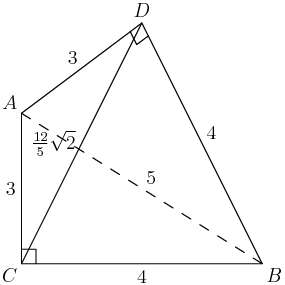

awesomethree
2015-02-04 19:07:42
Find the altitude
Find the altitude
thiennguyen
2015-02-04 19:07:42
figure out the height
figure out the height
thetank
2015-02-04 19:07:42
find tha base area
find tha base area
DeathLlama9
2015-02-04 19:07:42
Find the height!
Find the height!
Studiosa
2015-02-04 19:07:42
Right angles, so area of base times height
Right angles, so area of base times height
blueberry7
2015-02-04 19:07:42
find the height
find the height
copeland
2015-02-04 19:07:51
The formula for the volume is 13bh, where b is the area of a base, and h is the height to that base.
The formula for the volume is 13bh, where b is the area of a base, and h is the height to that base.
copeland
2015-02-04 19:07:55
We can find base areas easily enough: [ABC]=[ABD]=6 gives us two candidates for bases. What about heights?
We can find base areas easily enough: [ABC]=[ABD]=6 gives us two candidates for bases. What about heights?
copeland
2015-02-04 19:08:02
Let's draw in the two heights and see if that helps. How?
Let's draw in the two heights and see if that helps. How?
AlcumusGuy
2015-02-04 19:08:46
draw an altitude
draw an altitude
pedronr
2015-02-04 19:08:46
Draw the altitudes of the right triangles
Draw the altitudes of the right triangles
qwerty137
2015-02-04 19:08:46
altitudes from C and D to AB are 12/5
altitudes from C and D to AB are 12/5
gradysocool
2015-02-04 19:08:46
Find the altitude of ADB connecting to AB?
Find the altitude of ADB connecting to AB?
swirlykick
2015-02-04 19:08:46
notice the altitude to hypotenuse of 3-4-5 triangle is 12/5
notice the altitude to hypotenuse of 3-4-5 triangle is 12/5
legozelda
2015-02-04 19:08:46
altitude of ABC and ABD from side length 5 make a right triangle(12.5)
altitude of ABC and ABD from side length 5 make a right triangle(12.5)
awesomethree
2015-02-04 19:08:46
From D to AB
From D to AB
Blobbypie
2015-02-04 19:08:46
Draw heights to 345 triangles
Draw heights to 345 triangles
copeland
2015-02-04 19:08:50
Well, we can start by drawing the altitudes on the bases first. That is, I'll draw the altitude from C to ¯AB, and the altitude from D to ¯AB.
Well, we can start by drawing the altitudes on the bases first. That is, I'll draw the altitude from C to ¯AB, and the altitude from D to ¯AB.
copeland
2015-02-04 19:09:00
These go to the same point because the two faces ABC and ABD are congruent, the two altitudes will hit ¯AB at the same point. Let's call it X.
These go to the same point because the two faces ABC and ABD are congruent, the two altitudes will hit ¯AB at the same point. Let's call it X.
copeland
2015-02-04 19:09:08
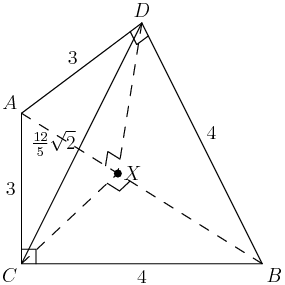

copeland
2015-02-04 19:09:27
What (if anything) do we know about X? CX? DX?
What (if anything) do we know about X? CX? DX?
warrenwangtennis
2015-02-04 19:09:45
DX = 12/5!
DX = 12/5!
Deathranger999
2015-02-04 19:09:45
The altitude will be 12/5.
The altitude will be 12/5.
pnpiano
2015-02-04 19:09:45
CX = 12/5 and Dx = 12/5 and both are heights
CX = 12/5 and Dx = 12/5 and both are heights
danusv
2015-02-04 19:09:45
DX^2+C^2=CD^2 because altitude of a 345 triangle is 12/5
DX^2+C^2=CD^2 because altitude of a 345 triangle is 12/5
ninjataco
2015-02-04 19:09:45
CX=DX=12/5
CX=DX=12/5
fluffyanimal
2015-02-04 19:09:45
XD=XC=12/5
XD=XC=12/5
spin8
2015-02-04 19:09:45
cx-12/5
cx-12/5
copeland
2015-02-04 19:09:54
The area of ABC is 6, so 12(CX)(AB)=6.
The area of ABC is 6, so 12(CX)(AB)=6.
copeland
2015-02-04 19:09:55
But AB=5, so that means CX=125.
But AB=5, so that means CX=125.
copeland
2015-02-04 19:09:58
Aha! There's already a 125 in our diagram. That's probably not a coincidence!
Aha! There's already a 125 in our diagram. That's probably not a coincidence!
copeland
2015-02-04 19:09:59
By symmetry, DX=125 too.
By symmetry, DX=125 too.
copeland
2015-02-04 19:10:00
So what does that tell us about triangle CXD?
So what does that tell us about triangle CXD?
mathwizard888
2015-02-04 19:10:29
isosceles right
isosceles right
WhaleVomit
2015-02-04 19:10:29
its a 45-45-90 triangle
its a 45-45-90 triangle
champion999
2015-02-04 19:10:29
cxd is a 45 45 90 triangle
cxd is a 45 45 90 triangle
ExuberantGPACN
2015-02-04 19:10:29
45 45 90 right triangle!
45 45 90 right triangle!
GU35T-31415
2015-02-04 19:10:29
45-45-90 triangle
45-45-90 triangle
FlyingWombat
2015-02-04 19:10:29
45-45-90 triangle
45-45-90 triangle
liopoil
2015-02-04 19:10:29
it must be a 45-45-90 triangle
it must be a 45-45-90 triangle
elpers21
2015-02-04 19:10:29
45 45 90 triangle
45 45 90 triangle
mjoshi
2015-02-04 19:10:29
isosceles right
isosceles right
copeland
2015-02-04 19:10:32
It's an isosceles right triangle! (The hypotenuse CD is √2 times the equal legs CX and DX.)
It's an isosceles right triangle! (The hypotenuse CD is √2 times the equal legs CX and DX.)
copeland
2015-02-04 19:10:34
So what?
So what?
6stars
2015-02-04 19:11:19
we have the height
we have the height
andycai2000
2015-02-04 19:11:19
and, more importantly, it tells us that DX and CX are heights for the tetrahedron
and, more importantly, it tells us that DX and CX are heights for the tetrahedron
MathCompetitor0606
2015-02-04 19:11:19
we can get the height now, which is 12/5
we can get the height now, which is 12/5
bookworm2003
2015-02-04 19:11:19
The height is also 12/5
The height is also 12/5
Quadratic64
2015-02-04 19:11:19
DX is perpendicular to plane of ABC
DX is perpendicular to plane of ABC
5cmpersun
2015-02-04 19:11:19
12/5 is the height
12/5 is the height
pnpiano
2015-02-04 19:11:19
we have the height =12/5
we have the height =12/5
CornSaltButter
2015-02-04 19:11:19
The altitude for our 3-4-5 (12/5) is also our height for the pyramid!
The altitude for our 3-4-5 (12/5) is also our height for the pyramid!
Kevin100
2015-02-04 19:11:19
so 12/5 is the altitude to our 3-4-5 base
so 12/5 is the altitude to our 3-4-5 base
copeland
2015-02-04 19:11:21
So, that means that ¯DX is perpendicular to ¯CX.
So, that means that ¯DX is perpendicular to ¯CX.
copeland
2015-02-04 19:11:24
And since we already knew that ¯DX is perpendicular to ¯AB as well, we can conclude that ¯DX is perpendicular to the plane containing ABC. That is, ¯DX is the altitude from D to the plane containing ABC.
And since we already knew that ¯DX is perpendicular to ¯AB as well, we can conclude that ¯DX is perpendicular to the plane containing ABC. That is, ¯DX is the altitude from D to the plane containing ABC.
copeland
2015-02-04 19:11:25
So DX is the height to base ABC, and now we can compute the volume.
So DX is the height to base ABC, and now we can compute the volume.
MathMaestro9
2015-02-04 19:11:58
It is 24/5 I think.
It is 24/5 I think.
wehac
2015-02-04 19:11:58
the volume is 1/3*12/5*6=24/5
the volume is 1/3*12/5*6=24/5
Wiggle Wam
2015-02-04 19:11:58
6⋅12/5⋅1/3=245
6⋅12/5⋅1/3=245
yayups
2015-02-04 19:11:58
C
C
yayups
2015-02-04 19:11:58
24/5
24/5
SimonSun
2015-02-04 19:11:58
(c) 24/5
(c) 24/5
imak64
2015-02-04 19:11:58
24/5
24/5
math0127
2015-02-04 19:11:58
6 * 12/5 / 3 = 24/5
6 * 12/5 / 3 = 24/5
copeland
2015-02-04 19:12:01
The volume is
13bh=13(DX)[ABC]=13⋅125⋅6=245.
Answer (C).
The volume is
13bh=13(DX)[ABC]=13⋅125⋅6=245.
Answer (C).
copeland
2015-02-04 19:12:05
Alright, good start.
Alright, good start.
copeland
2015-02-04 19:12:12
22. Eight people are sitting around a circular table, each holding a fair coin. All eight people flip their coins and those who flip heads stand while those who flip tails remain seated. What is the probability that no two adjacent people will stand?
peekaboo!
(A) 47256(B) 316(C) 49256(D) 25128(E) 51256
22. Eight people are sitting around a circular table, each holding a fair coin. All eight people flip their coins and those who flip heads stand while those who flip tails remain seated. What is the probability that no two adjacent people will stand?
peekaboo!
(A) 47256(B) 316(C) 49256(D) 25128(E) 51256
copeland
2015-02-04 19:12:18
Probability problem. What's this smell like to you?
Probability problem. What's this smell like to you?
ompatel99
2015-02-04 19:12:59
Cases?
Cases?
JoyAn
2015-02-04 19:12:59
casework
casework
az_phx_brandon_jiang
2015-02-04 19:12:59
Casework
Casework
zmyshatlp
2015-02-04 19:12:59
casework!
casework!
mathwrath
2015-02-04 19:12:59
Casework
Casework
ralph4imo
2015-02-04 19:12:59
Casework!
Casework!
copeland
2015-02-04 19:13:02
I'm getting a strong urge to try casework here.
I'm getting a strong urge to try casework here.
copeland
2015-02-04 19:13:04
We have 28=256 total ways to flip 8 coins. We need to count all the ways that the flips can come up such that no two heads are adjacent.
We have 28=256 total ways to flip 8 coins. We need to count all the ways that the flips can come up such that no two heads are adjacent.
copeland
2015-02-04 19:13:05
What are the cases?
What are the cases?
TheStrangeCharm
2015-02-04 19:13:42
0,1,2,3, or 4 heads
0,1,2,3, or 4 heads
NeilOnnsu
2015-02-04 19:13:42
0, 1, 2, 3, or 4 heads
0, 1, 2, 3, or 4 heads
ryanyoo
2015-02-04 19:13:42
4 people standing, 3, 2, 1, none
4 people standing, 3, 2, 1, none
cumo99
2015-02-04 19:13:42
0,1,2,3,4 people
0,1,2,3,4 people
bli1999
2015-02-04 19:13:42
0, 1, 2, 3, 4 heads
0, 1, 2, 3, 4 heads
mathway
2015-02-04 19:13:42
0,1,2,3,4 people stand up
0,1,2,3,4 people stand up
pedronr
2015-02-04 19:13:42
number of people who flip heads is 0,1,2,3,4
number of people who flip heads is 0,1,2,3,4
GeorgCantor
2015-02-04 19:13:42
1 person stands up, 2 people stand up, etc
1 person stands up, 2 people stand up, etc
kunsun
2015-02-04 19:13:42
0 standing, 1 standing, ... up to 4 standing
0 standing, 1 standing, ... up to 4 standing
MathStudent2002
2015-02-04 19:13:42
0 people stand, 1 person stands, 2 people stand, 3 people stand, 4 people stand
0 people stand, 1 person stands, 2 people stand, 3 people stand, 4 people stand
copeland
2015-02-04 19:13:44
We can have 0, 1, 2, 3, or 4 heads. Any more and we would need to have two neighbors come up heads.
We can have 0, 1, 2, 3, or 4 heads. Any more and we would need to have two neighbors come up heads.
copeland
2015-02-04 19:13:47
So it's a constructive casework problem. I find these really soothing when I don't have anything else to do and there is no need to rush. . .
So it's a constructive casework problem. I find these really soothing when I don't have anything else to do and there is no need to rush. . .
copeland
2015-02-04 19:13:51
How many ways can we flip 0 heads?
How many ways can we flip 0 heads?
lucylai
2015-02-04 19:14:12
1
1
yayups
2015-02-04 19:14:12
1
1
mjlove
2015-02-04 19:14:12
1 way
1 way
Gina
2015-02-04 19:14:12
1 way
1 way
RoboMan
2015-02-04 19:14:12
1
1
kungfugirl
2015-02-04 19:14:12
1
1
Elaine09
2015-02-04 19:14:12
1
1
jeremylu
2015-02-04 19:14:12
1
1
prpaxson
2015-02-04 19:14:12
1
1
copeland
2015-02-04 19:14:15
Just 1. Everyone flips tails.
Just 1. Everyone flips tails.
copeland
2015-02-04 19:14:17
How many ways can we flip 1 heads?
How many ways can we flip 1 heads?
mattlim
2015-02-04 19:14:44
There are 8 ways to flip one head
There are 8 ways to flip one head
gradysocool
2015-02-04 19:14:44
8
8
JoyAn
2015-02-04 19:14:44
8
8
blueberry7
2015-02-04 19:14:44
8
8
Annabeth
2015-02-04 19:14:44
8 ways
8 ways
coolcandii
2015-02-04 19:14:44
8
8
DeathLlama9
2015-02-04 19:14:44
8
8
Elaine09
2015-02-04 19:14:44
8
8
Jwilson1990J
2015-02-04 19:14:44
8
8
vimathur
2015-02-04 19:14:44
8
8
shakeNbake
2015-02-04 19:14:44
8
8
copeland
2015-02-04 19:14:47
There are 8 choices for who flips heads and since there is only one, there can't be two next to each other.
There are 8 choices for who flips heads and since there is only one, there can't be two next to each other.
copeland
2015-02-04 19:14:54
Let's look at flipping 2 heads. What should we do?
Let's look at flipping 2 heads. What should we do?
geogirl08
2015-02-04 19:15:42
complementary
complementary
mishka1980
2015-02-04 19:15:42
We do (82)−8
We do (82)−8
GU35T-31415
2015-02-04 19:15:42
Count total and subtract the consecutive pairs
Count total and subtract the consecutive pairs
ryanyoo
2015-02-04 19:15:42
8C2 - 8 = pick any two spots, subtract adjacent cases
8C2 - 8 = pick any two spots, subtract adjacent cases
yuunderstand168
2015-02-04 19:15:42
8 choose 2 - 8
8 choose 2 - 8
DeathLlama9
2015-02-04 19:15:42
8c2 - (number of ways for them to be next to each other)
8c2 - (number of ways for them to be next to each other)
donot
2015-02-04 19:15:42
(82) (ways to flip 2 heads) minus 8 (number of pairs)=20?
(82) (ways to flip 2 heads) minus 8 (number of pairs)=20?
copeland
2015-02-04 19:15:44
We could say that there are (82)=28 different ways to flip 2 heads and 8 of those are bad (there are 8 pairs of neighbors and each pair is determined by its leftmost member). That gives 20.
We could say that there are (82)=28 different ways to flip 2 heads and 8 of those are bad (there are 8 pairs of neighbors and each pair is determined by its leftmost member). That gives 20.
warrenwangtennis
2015-02-04 19:16:16
8 choices for first one, 5 ways for second, but divide by 2!
8 choices for first one, 5 ways for second, but divide by 2!
CombatOmega
2015-02-04 19:16:16
8 * 5, instead of 8 * 7, because it can't be the people next to the first
8 * 5, instead of 8 * 7, because it can't be the people next to the first
hjl00
2015-02-04 19:16:16
8 * 5 / 2 = 20
8 * 5 / 2 = 20
MathCompetitor0606
2015-02-04 19:16:16
8 times 5 seats.. since they can't be adjacent
8 times 5 seats.. since they can't be adjacent
copeland
2015-02-04 19:16:18
Alternatively, we could pick one of the 8 to be heads and that leaves 5 others who could also be heads. But. . .
Alternatively, we could pick one of the 8 to be heads and that leaves 5 others who could also be heads. But. . .
copeland
2015-02-04 19:16:22
that overcounts by a factor of 2 since we could pick in either order. This gives 8⋅52=20 again.
that overcounts by a factor of 2 since we could pick in either order. This gives 8⋅52=20 again.
copeland
2015-02-04 19:16:25
What about three heads? Theories for how to count that?
What about three heads? Theories for how to count that?
legozelda
2015-02-04 19:17:07
for 3 use casework where for the bad outcomes, either 3 in a row or 2 and 1 away
for 3 use casework where for the bad outcomes, either 3 in a row or 2 and 1 away
fractal161
2015-02-04 19:17:07
Sub-casework?
Sub-casework?
ninjataco
2015-02-04 19:17:07
complementary again
complementary again
Kevin100
2015-02-04 19:17:07
there are 2 further cases - sitting 2 away or 3/4 away from the first guy
there are 2 further cases - sitting 2 away or 3/4 away from the first guy
geogirl08
2015-02-04 19:17:07
complements again?
complements again?
copeland
2015-02-04 19:17:11
We can place three heads in (83)=56 ways. That counts 8 bad ways to put all three together. That also counts the bad ways to put two together with another singleton.
We can place three heads in (83)=56 ways. That counts 8 bad ways to put all three together. That also counts the bad ways to put two together with another singleton.
copeland
2015-02-04 19:17:13
How many ways can you place 2 heads together and then another singleton?
How many ways can you place 2 heads together and then another singleton?
DeathLlama9
2015-02-04 19:17:36
Singleton?
Singleton?
blueduck1
2015-02-04 19:17:36
What is a singleton
What is a singleton
copeland
2015-02-04 19:17:38
One by himself.
One by himself.
swirlykick
2015-02-04 19:17:53
8*4=32
8*4=32
sl_huskies
2015-02-04 19:17:53
8*4=32
8*4=32
CornSaltButter
2015-02-04 19:17:53
8*4=32
8*4=32
ExuberantGPACN
2015-02-04 19:17:53
8 x 4 = 32
8 x 4 = 32
fluffyanimal
2015-02-04 19:17:53
8x4=32
8x4=32
alex31415
2015-02-04 19:17:53
8x4=32
8x4=32
BFYSharks
2015-02-04 19:17:53
4*8?
4*8?
Abecissa
2015-02-04 19:17:53
8*4=32
8*4=32
copeland
2015-02-04 19:17:55
There are 8 places for the singleton and then the pair needs to be among the other 5. There are 4 neighboring pairs so there are 8⋅4=32 total bad flips with a pair and a singleton.
There are 8 places for the singleton and then the pair needs to be among the other 5. There are 4 neighboring pairs so there are 8⋅4=32 total bad flips with a pair and a singleton.
copeland
2015-02-04 19:17:56
There are 56−8−32=16 total successful 3-head flips.
There are 56−8−32=16 total successful 3-head flips.
copeland
2015-02-04 19:18:01
Or we could also just try placing all the heads. They must be configured like this:
Or we could also just try placing all the heads. They must be configured like this:
copeland
2015-02-04 19:18:05
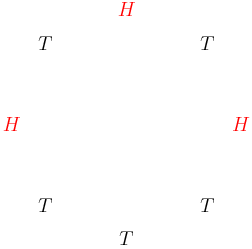

copeland
2015-02-04 19:18:09
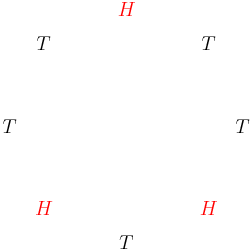

copeland
2015-02-04 19:18:12
There are 8 distinct ways to rotate each of these so 16 total successful 3-head flips.
There are 8 distinct ways to rotate each of these so 16 total successful 3-head flips.
copeland
2015-02-04 19:18:16
What about 4 heads?
What about 4 heads?
andycai2000
2015-02-04 19:18:42
2
2
awesomethree
2015-02-04 19:18:42
2, cause odd or even
2, cause odd or even
droid347
2015-02-04 19:18:42
2 ways?
2 ways?
1491625E
2015-02-04 19:18:42
2
2
kwausouq
2015-02-04 19:18:42
2 ways
2 ways
ericding
2015-02-04 19:18:42
2
2
danusv
2015-02-04 19:18:42
2 ways
2 ways
briyellowduck
2015-02-04 19:18:42
2
2
copeland
2015-02-04 19:18:44
There are only 2 4-head successes:
There are only 2 4-head successes:
copeland
2015-02-04 19:18:46
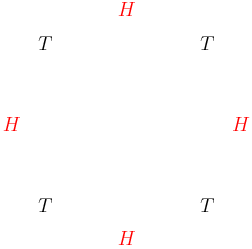

copeland
2015-02-04 19:18:48
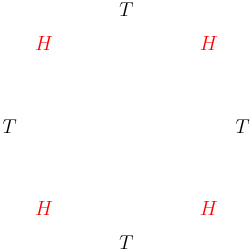

copeland
2015-02-04 19:18:49
So the answer?
So the answer?
Seasend
2015-02-04 19:19:32
47/256
47/256
SimonSun
2015-02-04 19:19:32
(C)
(C)
eswa2000
2015-02-04 19:19:32
A
A
math_cool
2015-02-04 19:19:32
47/256 = A
47/256 = A
pfalcon607133
2015-02-04 19:19:32
A
A
subhasri
2015-02-04 19:19:32
2
2
MathematicsOfPi
2015-02-04 19:19:32
47256
47256
Jayjayliu
2015-02-04 19:19:32
47
47
yimingz89
2015-02-04 19:19:32
47/256 a)
47/256 a)
jfei2001
2015-02-04 19:19:32
47/256
47/256
bomb427006
2015-02-04 19:19:32
47/256 (A)
47/256 (A)
MathMaestro9
2015-02-04 19:19:32
so it is 47/256
so it is 47/256
GeorgCantor
2015-02-04 19:19:32
1 + 8 + 20 + 32 + 2
1 + 8 + 20 + 32 + 2
wcao9311
2015-02-04 19:19:32
A 47/256
A 47/256
copeland
2015-02-04 19:19:35
We divide by the total number of options to get a probability: 1+8+20+16+2256=47256. The answer is A.
We divide by the total number of options to get a probability: 1+8+20+16+2256=47256. The answer is A.
copeland
2015-02-04 19:19:46
Alright, cool. Now we're rocking.
Alright, cool. Now we're rocking.
Deathranger999
2015-02-04 19:19:54
Is there a way to do that without casework?
Is there a way to do that without casework?
copeland
2015-02-04 19:19:56
Yes.
Yes.
copeland
2015-02-04 19:20:12
If you make every heads have a tails following it, then all the heads come in 2-person bricks.
If you make every heads have a tails following it, then all the heads come in 2-person bricks.
copeland
2015-02-04 19:20:19
HT
HT
copeland
2015-02-04 19:20:22
Or you could just drop an extra tails, T.
Or you could just drop an extra tails, T.
copeland
2015-02-04 19:20:32
So you're tiling the circle with squares and dominoes.
So you're tiling the circle with squares and dominoes.
copeland
2015-02-04 19:20:41
Something, something, Fibonacci, and then you're done.
Something, something, Fibonacci, and then you're done.
liopoil
2015-02-04 19:21:00
that sounds more elegant
that sounds more elegant
liopoil
2015-02-04 19:21:00
why didn't we do that?
why didn't we do that?
copeland
2015-02-04 19:21:02
Meh.
Meh.
copeland
2015-02-04 19:21:22
I thought this approach was a better illustration of the kinds of techniques you'd want at 10-22.
I thought this approach was a better illustration of the kinds of techniques you'd want at 10-22.
Seasend
2015-02-04 19:21:38
im sure the "squares and dominoes" would be faster and more efficient
im sure the "squares and dominoes" would be faster and more efficient
copeland
2015-02-04 19:21:44
If you remember your Fibonacci numbers.
If you remember your Fibonacci numbers.
mayaabiram
2015-02-04 19:22:08
you mean 10-12
you mean 10-12
b4200010
2015-02-04 19:22:08
10-22?
10-22?
Jwilson1990J
2015-02-04 19:22:08
whats 10-22
whats 10-22
copeland
2015-02-04 19:22:10
AMC 10, Problem 22. Sorry.
AMC 10, Problem 22. Sorry.
copeland
2015-02-04 19:22:13
23. The zeros of the function f(x)=x2−ax+2a are integers. What is the sum of the possible values of a?
peekaboo!
(A) 7(B) 8(C) 16(D) 17(E) 18
23. The zeros of the function f(x)=x2−ax+2a are integers. What is the sum of the possible values of a?
peekaboo!
(A) 7(B) 8(C) 16(D) 17(E) 18
copeland
2015-02-04 19:22:19
I've seen a lot of different solutions for this problem, so there are a lot of things we could start with.
I've seen a lot of different solutions for this problem, so there are a lot of things we could start with.
copeland
2015-02-04 19:22:22
As good contest-taking students, what tool should we grab first?
As good contest-taking students, what tool should we grab first?
DeathLlama9
2015-02-04 19:23:10
Vieta!
Vieta!
amburger66
2015-02-04 19:23:10
vieta's!
vieta's!
Gwena
2015-02-04 19:23:10
Vieta's formulas?
Vieta's formulas?
Ryukuxu
2015-02-04 19:23:10
vietas
vietas
bengals
2015-02-04 19:23:10
Vieta
Vieta
prpaxson
2015-02-04 19:23:10
viete's formula for x+y and xy
viete's formula for x+y and xy
aoommen1
2015-02-04 19:23:10
I wanted to use vietas formulas...not sure if thats right
I wanted to use vietas formulas...not sure if thats right
johnguolex
2015-02-04 19:23:10
vieta's formulas?
vieta's formulas?
copeland
2015-02-04 19:23:20
Vieta! If the roots are u and v then the linear term gives u+v=a and uv=2a. Let's hang on to that.
Vieta! If the roots are u and v then the linear term gives u+v=a and uv=2a. Let's hang on to that.
copeland
2015-02-04 19:23:20
u+v=auv=2a
u+v=auv=2a
copeland
2015-02-04 19:23:23
What do you want to do with that now?
What do you want to do with that now?
ompatel99
2015-02-04 19:24:01
SFFT
SFFT
Teddys123
2015-02-04 19:24:01
sfft
sfft
warrenwangtennis
2015-02-04 19:24:01
SFFT
SFFT
6stars
2015-02-04 19:24:01
subtract the second from the first
subtract the second from the first
Smiley-Faces-88
2015-02-04 19:24:01
substiturte
substiturte
az_phx_brandon_jiang
2015-02-04 19:24:01
divide them
divide them
ExuberantGPACN
2015-02-04 19:24:01
Simon's Favorite Factoring Trick!
Simon's Favorite Factoring Trick!
shakeNbake
2015-02-04 19:24:01
multiply first equation by 2 and set equal
multiply first equation by 2 and set equal
Special_K
2015-02-04 19:24:01
divide
divide
copeland
2015-02-04 19:24:11
Two approaches. Both are eliminating a.
Two approaches. Both are eliminating a.
copeland
2015-02-04 19:24:15
Some people may choose to divide and some may choose to subtract. Let's go through both methods really quickly.
Some people may choose to divide and some may choose to subtract. Let's go through both methods really quickly.
copeland
2015-02-04 19:24:20
What do we worry about first when we divide?
What do we worry about first when we divide?
az_phx_brandon_jiang
2015-02-04 19:24:43
divide by 0
divide by 0
fz0718
2015-02-04 19:24:43
0
0
Psionic
2015-02-04 19:24:43
u + v = 0
u + v = 0
awesomethree
2015-02-04 19:24:43
0
0
bli1999
2015-02-04 19:24:43
0
0
jigglypuff
2015-02-04 19:24:43
divide by 0
divide by 0
johnguolex
2015-02-04 19:24:43
if something is 0
if something is 0
fluffyanimal
2015-02-04 19:24:43
a=0
a=0
MathStudent2002
2015-02-04 19:24:43
a=0
a=0
luillo1
2015-02-04 19:24:43
0
0
copeland
2015-02-04 19:24:45
We need to make sure not to miss any a=0 solutions. Is there a solution with a=0?
We need to make sure not to miss any a=0 solutions. Is there a solution with a=0?
hibiscus
2015-02-04 19:25:24
Yesp.
Yesp.
swirlykick
2015-02-04 19:25:24
yes
yes
alex31415
2015-02-04 19:25:24
Yes, u=v=0
Yes, u=v=0
blueduck1
2015-02-04 19:25:24
Yes
Yes
p2pcmlp
2015-02-04 19:25:24
yes
yes
aswu
2015-02-04 19:25:24
yes
yes
RocketSingh
2015-02-04 19:25:24
yes
yes
flyrain
2015-02-04 19:25:24
u=0 and v=0 if you want that
u=0 and v=0 if you want that
NeilOnnsu
2015-02-04 19:25:24
Even if there were it wouldn't affect the sum
Even if there were it wouldn't affect the sum
zmyshatlp
2015-02-04 19:25:24
yeah
yeah
jameswangisb
2015-02-04 19:25:24
Yes
Yes
b4200010
2015-02-04 19:25:24
but it won't matter anyways because 0 contributes nothing to the sum
but it won't matter anyways because 0 contributes nothing to the sum
jeremylu
2015-02-04 19:25:24
yea
yea
Dukejukem
2015-02-04 19:25:24
Maybe, but it doesn't affect the sum of possible values
Maybe, but it doesn't affect the sum of possible values
copeland
2015-02-04 19:25:27
Honestly, I don't care. We want the sum of all possible a values so whether or not a=0 gets added to that sum is irrelevant. For funsies, u=v=0 does give a=0 as a solution.
Honestly, I don't care. We want the sum of all possible a values so whether or not a=0 gets added to that sum is irrelevant. For funsies, u=v=0 does give a=0 as a solution.
copeland
2015-02-04 19:25:33
Now we assume a≠0 and we divide. That givesu+vuv=a2a or
Now we assume a≠0 and we divide. That givesu+vuv=a2a or
copeland
2015-02-04 19:25:34
1u+1v=12.
1u+1v=12.
copeland
2015-02-04 19:25:39
Alright, one of them has to be positive. Let's let u be positive and explore.
Alright, one of them has to be positive. Let's let u be positive and explore.
copeland
2015-02-04 19:25:42
Can you solve11+1v=12?
Can you solve11+1v=12?
Tuxianeer
2015-02-04 19:25:55
v = -2
v = -2
CornSaltButter
2015-02-04 19:25:55
v=-2
v=-2
legolego
2015-02-04 19:25:55
-2
-2
stan23456
2015-02-04 19:25:55
v=-2
v=-2
mathtastic
2015-02-04 19:25:55
obvious v=-2
obvious v=-2
warrenwangtennis
2015-02-04 19:25:55
-2
-2
hjl00
2015-02-04 19:25:55
-1/2
-1/2
copeland
2015-02-04 19:25:59
v=−2 solves this. What is a?
v=−2 solves this. What is a?
wcao9311
2015-02-04 19:26:19
-1
-1
elpers21
2015-02-04 19:26:19
-1
-1
lucylai
2015-02-04 19:26:19
-1
-1
Kevin100
2015-02-04 19:26:19
-1
-1
flyrain
2015-02-04 19:26:19
-1
-1
Ultimate_draco
2015-02-04 19:26:19
-1
-1
copeland
2015-02-04 19:26:20
a=u+v=−1.
a=u+v=−1.
copeland
2015-02-04 19:26:23
Can you solve12+1v=12?
Can you solve12+1v=12?
cmw1234
2015-02-04 19:26:45
no
no
atd09
2015-02-04 19:26:45
no
no
SimonSun
2015-02-04 19:26:45
NOOOOO
NOOOOO
brian22
2015-02-04 19:26:45
v=INFINITY
v=INFINITY
bomb427006
2015-02-04 19:26:45
no
no
ask2001
2015-02-04 19:26:45
no
no
viv7000
2015-02-04 19:26:45
no solution
no solution
MathCompetitor0606
2015-02-04 19:26:45
no
no
skimisgod
2015-02-04 19:26:45
no
no
copeland
2015-02-04 19:26:46
NO!
NO!
copeland
2015-02-04 19:26:47
Can you solve13+1v=12?
Can you solve13+1v=12?
bharatputra
2015-02-04 19:27:10
yes v=6
yes v=6
jfsn7
2015-02-04 19:27:10
v=6
v=6
MathematicsOfPi
2015-02-04 19:27:10
v = 6
v = 6
danusv
2015-02-04 19:27:10
yes v=6
yes v=6
Blazefang
2015-02-04 19:27:10
6
6
GeorgCantor
2015-02-04 19:27:10
v=6
v=6
legozelda
2015-02-04 19:27:10
6
6
kapilak
2015-02-04 19:27:10
6
6
TheStrangeCharm
2015-02-04 19:27:10
yeah, classic, v - 6
yeah, classic, v - 6
bomb427006
2015-02-04 19:27:10
6, a=9
6, a=9
BFYSharks
2015-02-04 19:27:10
6
6
copeland
2015-02-04 19:27:14
v=6 solves this.
v=6 solves this.
copeland
2015-02-04 19:27:16
a=3+6=9.
a=3+6=9.
copeland
2015-02-04 19:27:18
Can you solve14+1v=12?
Can you solve14+1v=12?
tdeng
2015-02-04 19:27:40
4
4
thatmathgeek
2015-02-04 19:27:40
v = 4
v = 4
briyellowduck
2015-02-04 19:27:40
4
4
Psionic
2015-02-04 19:27:40
v = 4
v = 4
hibiscus
2015-02-04 19:27:40
4
4
leagueoflanguin
2015-02-04 19:27:40
4 !!!
4 !!!
owm
2015-02-04 19:27:40
v=4
v=4
blueflute19
2015-02-04 19:27:40
4
4
Deathranger999
2015-02-04 19:27:40
Yes, v = 4, a = 8.
Yes, v = 4, a = 8.
Picroft
2015-02-04 19:27:40
v=4
v=4
mathymath
2015-02-04 19:27:40
Yes v=4
Yes v=4
copeland
2015-02-04 19:27:54
v=4 solves this. In this case a=u+v=4+4=8.
v=4 solves this. In this case a=u+v=4+4=8.
copeland
2015-02-04 19:27:56
Gosh, this is going to take a while, right?
Gosh, this is going to take a while, right?
Tuxianeer
2015-02-04 19:28:20
nope we're done
nope we're done
elpers21
2015-02-04 19:28:20
that's all the solutions
that's all the solutions
bobispro5
2015-02-04 19:28:20
no youre done
no youre done
Yumantimatter
2015-02-04 19:28:20
no, thats it
no, thats it
copeland
2015-02-04 19:28:22
Nope, we're actually done. As u increases, v decreases. Since we just hit the point where u=v we are guaranteed not to find any new values of a.
Nope, we're actually done. As u increases, v decreases. Since we just hit the point where u=v we are guaranteed not to find any new values of a.
copeland
2015-02-04 19:28:30
So what's the answer?
So what's the answer?
MathMaestro9
2015-02-04 19:28:57
8+9-1=16
8+9-1=16
imath2013
2015-02-04 19:28:57
16
16
IequalSmart
2015-02-04 19:28:57
16!
16!
Deathranger999
2015-02-04 19:28:57
16
16
jkyman
2015-02-04 19:28:57
C 16
C 16
hwl0304
2015-02-04 19:28:57
C
C
yang2000
2015-02-04 19:28:57
C-16
C-16
copeland
2015-02-04 19:29:01
We want −1+9+8=16. The answer is C.
We want −1+9+8=16. The answer is C.
copeland
2015-02-04 19:29:07
Now for subtraction.
Now for subtraction.
copeland
2015-02-04 19:29:08
uv−2(u+v)=2a−2⋅a=0.
uv−2(u+v)=2a−2⋅a=0.
copeland
2015-02-04 19:29:18
What do we do with that?
What do we do with that?
mathway
2015-02-04 19:29:49
SFFT
SFFT
geogirl08
2015-02-04 19:29:49
SFFT
SFFT
math_cool
2015-02-04 19:29:49
SFFT
SFFT
ompatel99
2015-02-04 19:29:49
SFFT
SFFT
mjlove
2015-02-04 19:29:49
SFFT
SFFT
shakeNbake
2015-02-04 19:29:49
simons fav factoring trick
simons fav factoring trick
NumberNinja
2015-02-04 19:29:49
SFFT
SFFT
hnkevin42
2015-02-04 19:29:49
Simon's Favorite Factoring Trick
Simon's Favorite Factoring Trick
TheMaskedMagician
2015-02-04 19:29:49
Factor via SFFT
Factor via SFFT
ninjataco
2015-02-04 19:29:49
use SFFT!
use SFFT!
champion999
2015-02-04 19:29:49
SFFT it
SFFT it
copeland
2015-02-04 19:29:55
Simon's Favorite Factoring Trick! If we add 4 to both sides we get
Simon's Favorite Factoring Trick! If we add 4 to both sides we get
copeland
2015-02-04 19:29:57
uv−2u−2v+4=4 which now factors as (u−2)(v−2)=4.
uv−2u−2v+4=4 which now factors as (u−2)(v−2)=4.
copeland
2015-02-04 19:30:04
To clean things up, we could substitute x=u−2 and y=v−2 and now we want to find distinct a=u+v=x+y+4 given xy=4.
To clean things up, we could substitute x=u−2 and y=v−2 and now we want to find distinct a=u+v=x+y+4 given xy=4.
copeland
2015-02-04 19:30:08
Again we get
Again we get
copeland
2015-02-04 19:30:10
xyx+y+4419228149−1−4−1−2−20−4−1−1
xyx+y+4419228149−1−4−1−2−20−4−1−1
copeland
2015-02-04 19:30:19
(Obviously some of those are redundant by symmetry.)
(Obviously some of those are redundant by symmetry.)
copeland
2015-02-04 19:30:21
We get the same possible values for a so the answer is −1+0+8+9=16. (C).
We get the same possible values for a so the answer is −1+0+8+9=16. (C).
jkyman
2015-02-04 19:30:53
this way is easier
this way is easier
copeland
2015-02-04 19:30:54
Well, it was faster because I did it more quickly. I liked the fractions way because that's what I did.
Well, it was faster because I did it more quickly. I liked the fractions way because that's what I did.
copeland
2015-02-04 19:31:05
24. For some positive integers p, quadrilateral ABCD with positive integer side lengths has perimeter p, right angles at B and C, AB=2, and CD=AD. How many different values of p<2015 are possible?
peekaboo!
(A) 30(B) 31(C) 61(D) 62(E) 63
24. For some positive integers p, quadrilateral ABCD with positive integer side lengths has perimeter p, right angles at B and C, AB=2, and CD=AD. How many different values of p<2015 are possible?
peekaboo!
(A) 30(B) 31(C) 61(D) 62(E) 63
copeland
2015-02-04 19:31:22
Let's start by drawing a picture to get ourselves more comfortable with the problem.
Let's start by drawing a picture to get ourselves more comfortable with the problem.
danusv
2015-02-04 19:31:37
Draw a diagram!
Draw a diagram!
ompatel99
2015-02-04 19:31:37
picture!
picture!
cellobix
2015-02-04 19:31:37
Draw a picture.
Draw a picture.
copeland
2015-02-04 19:31:40
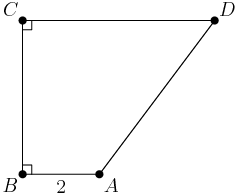

copeland
2015-02-04 19:31:44
Now we have a basic picture, but it isn't particularly enlightening.
Now we have a basic picture, but it isn't particularly enlightening.
copeland
2015-02-04 19:31:45
How could we improve this diagram?
How could we improve this diagram?
retrovirus721
2015-02-04 19:32:24
label congruent sides
label congruent sides
droid347
2015-02-04 19:32:24
label isoceles.
label isoceles.
wlpj11
2015-02-04 19:32:24
you can label things
you can label things
CornSaltButter
2015-02-04 19:32:24
label with, say x and y for the sides
label with, say x and y for the sides
RoboMan
2015-02-04 19:32:24
put values in for the reaining sides
put values in for the reaining sides
copeland
2015-02-04 19:32:27
Since we're concerned with the perimeter, it makes sense to assign variables to the side lengths.
Since we're concerned with the perimeter, it makes sense to assign variables to the side lengths.
copeland
2015-02-04 19:32:27
The problem tells us that CD=AD, so we only need two variables for our three sides. We'll call BC=x and CD=AD=y.
The problem tells us that CD=AD, so we only need two variables for our three sides. We'll call BC=x and CD=AD=y.
copeland
2015-02-04 19:32:30
So the perimeter is p=2y+x+2.
So the perimeter is p=2y+x+2.
copeland
2015-02-04 19:32:31
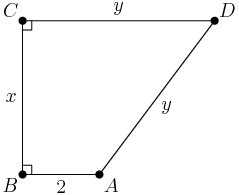

copeland
2015-02-04 19:32:33
At first, it may look like we can choose x,y to be any positive integers such that 2y+x+2<2015. Why is that not actually the case?
At first, it may look like we can choose x,y to be any positive integers such that 2y+x+2<2015. Why is that not actually the case?
jameswangisb
2015-02-04 19:33:17
line perpendicular to AB from A
line perpendicular to AB from A
SimonSun
2015-02-04 19:33:17
draw altudes!
draw altudes!
AlcumusGuy
2015-02-04 19:33:17
draw altitude from A to CD
draw altitude from A to CD
bobacadodl
2015-02-04 19:33:17
perpendicular from A to CD
perpendicular from A to CD
Naysh
2015-02-04 19:33:17
Drop the altitude from A to CD.
Drop the altitude from A to CD.
copeland
2015-02-04 19:33:22
x and y are related to each other. If we drop a perpendicular from A to side CD, we see a right triangle that relates x and y:
x and y are related to each other. If we drop a perpendicular from A to side CD, we see a right triangle that relates x and y:
copeland
2015-02-04 19:33:24
What does the Pythagorean Theorem tell us?
What does the Pythagorean Theorem tell us?
copeland
2015-02-04 19:33:24
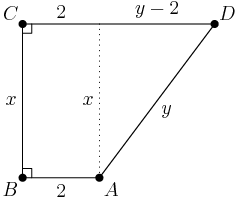

MathStudent2002
2015-02-04 19:33:52
x^2=y^2-(y-2)^2=4y+4
x^2=y^2-(y-2)^2=4y+4
droid347
2015-02-04 19:33:52
(y−2)2+x2=y2
(y−2)2+x2=y2
brian22
2015-02-04 19:33:52


swirlykick
2015-02-04 19:33:52
must satisfy pyth. for x^2 + (y-2)^2 = y^2
must satisfy pyth. for x^2 + (y-2)^2 = y^2
Deathranger999
2015-02-04 19:33:52
Pythagorean theorem might be useful, (y-2)^2 + x^2 = y^2.
Pythagorean theorem might be useful, (y-2)^2 + x^2 = y^2.
lucylai
2015-02-04 19:33:52
(y-2)^2+x^2=y^2
(y-2)^2+x^2=y^2
alex31415
2015-02-04 19:33:52
x^2+(y-2)^2=y^2
x^2+(y-2)^2=y^2
Duncanyang
2015-02-04 19:33:52
x^2+(y-2)^2=y^2
x^2+(y-2)^2=y^2
math0127
2015-02-04 19:33:52
y^2 = (y-2)^2 + x^2
y^2 = (y-2)^2 + x^2
Jayjayliu
2015-02-04 19:33:52
x^2+(y-2)^2=y^2
x^2+(y-2)^2=y^2
acsigaoyuan
2015-02-04 19:33:52
y^2=x^2+(y-2)^2
y^2=x^2+(y-2)^2
copeland
2015-02-04 19:33:55
By the Pythagorean Theorem, we have (y−2)2+x2=y2. Or, after expanding both sides and rearranging, x2=4y−4=4(y−1)
By the Pythagorean Theorem, we have (y−2)2+x2=y2. Or, after expanding both sides and rearranging, x2=4y−4=4(y−1)
copeland
2015-02-04 19:34:01
What does this tell us about x?
What does this tell us about x?
jigglypuff
2015-02-04 19:34:25
x is divisible by 2
x is divisible by 2
warrenwangtennis
2015-02-04 19:34:25
it is even
it is even
kkpanu9
2015-02-04 19:34:25
it is even
it is even
jigglypuff
2015-02-04 19:34:25
x is even
x is even
az_phx_brandon_jiang
2015-02-04 19:34:25
must be even
must be even
Ramanan369
2015-02-04 19:34:25
x is even
x is even
Annabeth
2015-02-04 19:34:25
x is even
x is even
ExuberantGPACN
2015-02-04 19:34:25
x is even
x is even
jhshi07
2015-02-04 19:34:25
x must be even
x must be even
aersoz
2015-02-04 19:34:25
x is even?
x is even?
copeland
2015-02-04 19:34:27
The integer restriction tells us that x is even, so we can write x=2z.
The integer restriction tells us that x is even, so we can write x=2z.
copeland
2015-02-04 19:34:32
Plugging x=2z into our equation, we see that 4z2=4(y−1), or y=z2+1.
Plugging x=2z into our equation, we see that 4z2=4(y−1), or y=z2+1.
copeland
2015-02-04 19:34:35
Now everything depends on our integer z. What is the perimeter in terms of z?
Now everything depends on our integer z. What is the perimeter in terms of z?
ninjataco
2015-02-04 19:35:24
2z^2 + 2z + 4
2z^2 + 2z + 4
acsigaoyuan
2015-02-04 19:35:24
2z^2+2z+4
2z^2+2z+4
flyrain
2015-02-04 19:35:24
2z^2+2z+4
2z^2+2z+4
ExuberantGPACN
2015-02-04 19:35:24
2z^2+2z+4
2z^2+2z+4
droid347
2015-02-04 19:35:24
2z^2+2z+4
2z^2+2z+4
CombatOmega
2015-02-04 19:35:24
2z^2 + 2z + 4
2z^2 + 2z + 4
ChrisY
2015-02-04 19:35:24
2z+2z^2+4
2z+2z^2+4
Yumantimatter
2015-02-04 19:35:24
2z+2z^2+4
2z+2z^2+4
copeland
2015-02-04 19:35:26
The perimeter is
p=2y+x+2=2(z2+1)+2z+2=2z2+2z+4
The perimeter is
p=2y+x+2=2(z2+1)+2z+2=2z2+2z+4
copeland
2015-02-04 19:35:28
Therefore, we simply need to count the positive integer z's such that 2z2+2z+4<2015.
Therefore, we simply need to count the positive integer z's such that 2z2+2z+4<2015.
copeland
2015-02-04 19:35:31
What is the largest possible z?
What is the largest possible z?
mathway
2015-02-04 19:35:56
31
31
trumpeter
2015-02-04 19:35:56
31
31
FractalMathHistory
2015-02-04 19:35:56
31
31
GU35T-31415
2015-02-04 19:35:56
31
31
p2pcmlp
2015-02-04 19:35:56
31
31
Abecissa
2015-02-04 19:35:56
31
31
QuadraticFanatic2416
2015-02-04 19:35:56
31
31
Tuxianeer
2015-02-04 19:35:56
31
31
atmath2011
2015-02-04 19:35:56
31
31
jslam
2015-02-04 19:35:56
31
31
MathematicsOfPi
2015-02-04 19:35:56
31
31
raidermath6
2015-02-04 19:35:56
31
31
copeland
2015-02-04 19:35:59
We're looking near z2≈1000. The square of 32 is 210=1024 (powers of 2 anybody?), so when z=32, 2z2+2z+4>2⋅1024=2048, so that's too big but just barely. The biggest value is probably 31.
We're looking near z2≈1000. The square of 32 is 210=1024 (powers of 2 anybody?), so when z=32, 2z2+2z+4>2⋅1024=2048, so that's too big but just barely. The biggest value is probably 31.
copeland
2015-02-04 19:36:08
312=961, so plugging in z=31 yields 2(961)+2(31)+4=1988<2015.
312=961, so plugging in z=31 yields 2(961)+2(31)+4=1988<2015.
copeland
2015-02-04 19:36:09
So the largest value of z is 31.
So the largest value of z is 31.
copeland
2015-02-04 19:36:23
Since x and y are both positive integers, the smallest z is 1.
Since x and y are both positive integers, the smallest z is 1.
copeland
2015-02-04 19:36:24
So what is our answer?
So what is our answer?
Studiosa
2015-02-04 19:36:43
B
B
CaptainFlint
2015-02-04 19:36:43
B
B
Duncanyang
2015-02-04 19:36:43
B
B
poweroftwo
2015-02-04 19:36:43
B
B
jigglypuff
2015-02-04 19:36:43
B) 31
B) 31
briyellowduck
2015-02-04 19:36:43
B) 31
B) 31
Psionic
2015-02-04 19:36:43
31
31
skimisgod
2015-02-04 19:36:43
B
B
yayups
2015-02-04 19:36:43
B
B
LMLM
2015-02-04 19:36:43
so the answer is B
so the answer is B
WhaleVomit
2015-02-04 19:36:43
31
31
blueflute19
2015-02-04 19:36:43
31
31
copeland
2015-02-04 19:36:45
Our answer is (B) 31.
Our answer is (B) 31.
copeland
2015-02-04 19:37:22
Alright, one more problem from the 10.
Alright, one more problem from the 10.
copeland
2015-02-04 19:37:32
25. Let S be a square of side length 1. Two points are chosen independently at random on the sides of S. The probability that the straight-line distance between the points
is at least 12 is a−bπc, where a, b, and c are positive integers and gcd(a,b,c)=1. What is a+b+c?
peekaboo!
(A) 59(B) 60(C) 61(D) 62(E) 63
25. Let S be a square of side length 1. Two points are chosen independently at random on the sides of S. The probability that the straight-line distance between the points
is at least 12 is a−bπc, where a, b, and c are positive integers and gcd(a,b,c)=1. What is a+b+c?
peekaboo!
(A) 59(B) 60(C) 61(D) 62(E) 63
copeland
2015-02-04 19:37:40
The way this problem is written, it kind of looks like it should be on the AIME. But don't let that scare you.
The way this problem is written, it kind of looks like it should be on the AIME. But don't let that scare you.
copeland
2015-02-04 19:37:43
We'll call the two points A and B. (That way we have don't have to say the first and second point over and over again.)
We'll call the two points A and B. (That way we have don't have to say the first and second point over and over again.)
copeland
2015-02-04 19:37:53
Let's start by looking at an example. Without loss of generality we can assume that our square has vertices (0,0),(0,1),(1,0), and (1,1).
Let's start by looking at an example. Without loss of generality we can assume that our square has vertices (0,0),(0,1),(1,0), and (1,1).
copeland
2015-02-04 19:37:55
For our example, suppose A is at (0,3/4).
For our example, suppose A is at (0,3/4).
copeland
2015-02-04 19:37:58
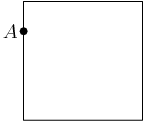

copeland
2015-02-04 19:38:14
Where can we place B such that the straight-line distance between A and B is at least 1/2?
Where can we place B such that the straight-line distance between A and B is at least 1/2?
zsp
2015-02-04 19:38:47
draw a circle
draw a circle
ninjataco
2015-02-04 19:38:47
outside the circle of radius 1/2 centered at A
outside the circle of radius 1/2 centered at A
Picroft
2015-02-04 19:38:47
Outside a circle of radius 1/2
Outside a circle of radius 1/2
LMLM
2015-02-04 19:38:47
We can draw a circle with radius of 1/2, and figure out where be can go
We can draw a circle with radius of 1/2, and figure out where be can go
cellobix
2015-02-04 19:38:47
Outside of the circle of radius 1/2 centered around A.
Outside of the circle of radius 1/2 centered around A.
bookworm2003
2015-02-04 19:38:47
anywhere inside the square and outside the circle with center A and radius 1/2
anywhere inside the square and outside the circle with center A and radius 1/2
copeland
2015-02-04 19:38:52
If we draw a circle of radius 1/2 centered at A, we want B outside of this circle.
If we draw a circle of radius 1/2 centered at A, we want B outside of this circle.
copeland
2015-02-04 19:38:55
We'll color these points in blue.
We'll color these points in blue.
copeland
2015-02-04 19:38:56
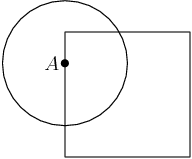

copeland
2015-02-04 19:38:57
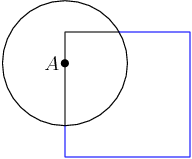

copeland
2015-02-04 19:39:08
Let's find the boundary points for the blue region.
Let's find the boundary points for the blue region.
copeland
2015-02-04 19:39:09
What is the boundary point on the left side of the square?
What is the boundary point on the left side of the square?
BFYSharks
2015-02-04 19:39:29
(0,1/4)
(0,1/4)
ompatel99
2015-02-04 19:39:29
(0,1/4)
(0,1/4)
swirlykick
2015-02-04 19:39:29
(0,1/4)
(0,1/4)
mjoshi
2015-02-04 19:39:29
(0, 1/4)
(0, 1/4)
Destructio
2015-02-04 19:39:29
0, 1/4
0, 1/4
amburger66
2015-02-04 19:39:29
(0,1/4)
(0,1/4)
atmchallenge
2015-02-04 19:39:29
(0,1/4)
(0,1/4)
hnkevin42
2015-02-04 19:39:29
(0, 1/4)
(0, 1/4)
MathMaestro9
2015-02-04 19:39:29
0, 1/4
0, 1/4
anandiyer12
2015-02-04 19:39:29
(0,1/4)
(0,1/4)
copeland
2015-02-04 19:39:31
The point is a distance of 1/2 below A, so it is at (0,1/4).
The point is a distance of 1/2 below A, so it is at (0,1/4).
copeland
2015-02-04 19:39:37
By the Pythagorean Theorem, the second boundary point is at (√3/4,1)
By the Pythagorean Theorem, the second boundary point is at (√3/4,1)
copeland
2015-02-04 19:39:40
Let's calculate the probability that B is in the successful region, given our assumption that A is at (0,3/4).
Let's calculate the probability that B is in the successful region, given our assumption that A is at (0,3/4).
copeland
2015-02-04 19:39:43
Each side of the square looks a bit different, so we'll look at what happens on each side separately.
Each side of the square looks a bit different, so we'll look at what happens on each side separately.
copeland
2015-02-04 19:39:52
What is the probability that B is in the successful region if it is on the left side?
What is the probability that B is in the successful region if it is on the left side?
liopoil
2015-02-04 19:40:18
1/4
1/4
richy
2015-02-04 19:40:18
1/4
1/4
alex31415
2015-02-04 19:40:18
1/4
1/4
viv7000
2015-02-04 19:40:18
1/4
1/4
Empoleon2000
2015-02-04 19:40:18
1/4
1/4
Kevin100
2015-02-04 19:40:18
1/4
1/4
TigerLily14
2015-02-04 19:40:18
1/4
1/4
blueberry7
2015-02-04 19:40:18
1/4
1/4
CJaws
2015-02-04 19:40:18
1/4
1/4
bli1999
2015-02-04 19:40:18
1/4
1/4
copeland
2015-02-04 19:40:24
Since the boundary point on this side of the square is at (0,1/4), the probability is 1/4.
Since the boundary point on this side of the square is at (0,1/4), the probability is 1/4.
copeland
2015-02-04 19:40:26
The boundary point on the top of the square is at (√3/4,1), so the probability is 1−√3/4.
The boundary point on the top of the square is at (√3/4,1), so the probability is 1−√3/4.
copeland
2015-02-04 19:40:36
And on the other two sides?
And on the other two sides?
bomb427006
2015-02-04 19:40:54
1
1
jprogrammer
2015-02-04 19:40:54
1
1
amburger66
2015-02-04 19:40:54
1
1
mathmass
2015-02-04 19:40:54
1
1
acsigaoyuan
2015-02-04 19:40:54
1
1
hnkevin42
2015-02-04 19:40:54
1!
1!
pearlm
2015-02-04 19:40:54
1 and 1
1 and 1
jkyman
2015-02-04 19:40:54
1
1
Empoleon2000
2015-02-04 19:40:54
1 and 1
1 and 1
Duncanyang
2015-02-04 19:40:54
1 on each
1 on each
copeland
2015-02-04 19:40:59
Since the entire bottom and right sides are included in the successful region, the probability is 1 if B is on one of those sides.
Since the entire bottom and right sides are included in the successful region, the probability is 1 if B is on one of those sides.
copeland
2015-02-04 19:41:02
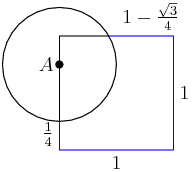

copeland
2015-02-04 19:41:04
The probability that B is on any given side is 1/4, so the probability that B is chosen in the successful region in our example is 14[14+1+1+(1−√34)].
The probability that B is on any given side is 1/4, so the probability that B is chosen in the successful region in our example is 14[14+1+1+(1−√34)].
copeland
2015-02-04 19:41:13
All right, let's try to work in a little more generally. First of all, by symmetry, we can still assume that A is on the left side of the square.
All right, let's try to work in a little more generally. First of all, by symmetry, we can still assume that A is on the left side of the square.
copeland
2015-02-04 19:41:20
Our example suggests that we might try examining what happens when B is on each side of the square separately.
Our example suggests that we might try examining what happens when B is on each side of the square separately.
copeland
2015-02-04 19:41:23
What happens if B is also chosen on the left side?
What happens if B is also chosen on the left side?
jigglypuff
2015-02-04 19:41:55
geometric probability
geometric probability
copeland
2015-02-04 19:41:59
OK, what do we draw?
OK, what do we draw?
az_phx_brandon_jiang
2015-02-04 19:43:03
We have -1/2<a-b<1/2
We have -1/2<a-b<1/2
AlcumusGuy
2015-02-04 19:43:03


TigerLily14
2015-02-04 19:43:03
abs(a-b)>=1/2
abs(a-b)>=1/2
cellobix
2015-02-04 19:43:03
A graph: position of A versus position of B. Draw the region where A and B are at least 1/2 apart.
A graph: position of A versus position of B. Draw the region where A and B are at least 1/2 apart.
liopoil
2015-02-04 19:43:03
it must have y-coordinate y_2 s.t. abs(y_1 - y_1) > 1/2
it must have y-coordinate y_2 s.t. abs(y_1 - y_1) > 1/2
copeland
2015-02-04 19:43:12
In this case the problem becomes: If a and b are chosen uniformly at random in the interval [0,1], what is the probability that |a−b|≥1/2?
In this case the problem becomes: If a and b are chosen uniformly at random in the interval [0,1], what is the probability that |a−b|≥1/2?
copeland
2015-02-04 19:43:25
Let's see how that works out. The region we're working with is 0≤a≤1 and 0≤b≤1.
Let's see how that works out. The region we're working with is 0≤a≤1 and 0≤b≤1.
copeland
2015-02-04 19:43:27
What is the successful region for a pair (a,b)?
What is the successful region for a pair (a,b)?
copeland
2015-02-04 19:43:28
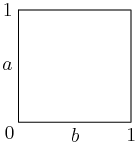

copeland
2015-02-04 19:43:50
As in, what does it look like?
As in, what does it look like?
ompatel99
2015-02-04 19:44:28
two triangles
two triangles
MathStudent2002
2015-02-04 19:44:28
its the square except wth 2 1/2 x 1/2 right triangles removed at the top right and bottom left corners
its the square except wth 2 1/2 x 1/2 right triangles removed at the top right and bottom left corners
mathymath
2015-02-04 19:44:28
Big long section that's diagonal in the middle
Big long section that's diagonal in the middle
awe-sum
2015-02-04 19:44:28
two triangles
two triangles
cellobix
2015-02-04 19:44:28
Mini triangles at the upper-left and lower-right corners.
Mini triangles at the upper-left and lower-right corners.
GU35T-31415
2015-02-04 19:44:28
two triangles, one at the top left and one at the bottom right. They are 45-45-90, with legs of length 1/2
two triangles, one at the top left and one at the bottom right. They are 45-45-90, with legs of length 1/2
TigerLily14
2015-02-04 19:44:28
2 shaded triangles on top left and bottom right
2 shaded triangles on top left and bottom right
AKAL3
2015-02-04 19:44:28
a square with triangular pieces chopped of at the upper left and lower right
a square with triangular pieces chopped of at the upper left and lower right
copeland
2015-02-04 19:44:30
(a,b) is successful if either a≥b+12 or a≤b−12.
(a,b) is successful if either a≥b+12 or a≤b−12.
copeland
2015-02-04 19:44:33
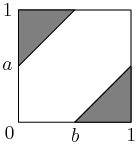

copeland
2015-02-04 19:44:35
The area of this region is 18+18=14.
The area of this region is 18+18=14.
copeland
2015-02-04 19:44:40
What happens if B is chosen on the top side?
What happens if B is chosen on the top side?
zsp
2015-02-04 19:45:06
This is harder
This is harder
copeland
2015-02-04 19:45:10
It IS harder. . .
It IS harder. . .
copeland
2015-02-04 19:45:27
So, assume A=(0,a). What do we know about B?
So, assume A=(0,a). What do we know about B?
liopoil
2015-02-04 19:46:05
$(1 - a)^2 + b^2 > 1/2
$(1 - a)^2 + b^2 > 1/2
az_phx_brandon_jiang
2015-02-04 19:46:05
b is at (b,1)
b is at (b,1)
fractal161
2015-02-04 19:46:05
point is (b, 1)
point is (b, 1)
LMLM
2015-02-04 19:46:05
b,1
b,1
cellobix
2015-02-04 19:46:05
B = (b, 1) for 0<b<1
B = (b, 1) for 0<b<1
copeland
2015-02-04 19:46:12
And what do we do with those?
And what do we do with those?
Studiosa
2015-02-04 19:46:36
distance formula
distance formula
az_phx_brandon_jiang
2015-02-04 19:46:36
distance formula
distance formula
LMLM
2015-02-04 19:46:36
(1−a)2+b2>1/2
(1−a)2+b2>1/2
ompatel99
2015-02-04 19:46:36
distance formula >=1/2
distance formula >=1/2
eswa2000
2015-02-04 19:46:36
do pythag
do pythag
Eridan
2015-02-04 19:46:36
Pythagorean theorem
Pythagorean theorem
jslam
2015-02-04 19:46:36
distance formula
distance formula
copeland
2015-02-04 19:46:39
Great.
Great.
copeland
2015-02-04 19:46:40
In this case, we can calculate the distance from A to B. If we write A=(0,a) and B=(b,1), then the distance is √(1−a)2+b2.
In this case, we can calculate the distance from A to B. If we write A=(0,a) and B=(b,1), then the distance is √(1−a)2+b2.
copeland
2015-02-04 19:46:45
(a,b) is successful if (1−a)2+b2≥14.
(a,b) is successful if (1−a)2+b2≥14.
copeland
2015-02-04 19:46:45
What does that equation say geometrically?
What does that equation say geometrically?
aersoz
2015-02-04 19:47:20
outside of the circle
outside of the circle
jigglypuff
2015-02-04 19:47:20
quarter circle
quarter circle
blueberry7
2015-02-04 19:47:20
circle!!
circle!!
ACSIXueZiming
2015-02-04 19:47:20
the circle's radius?
the circle's radius?
LMLM
2015-02-04 19:47:20
equation of a circle like object?
equation of a circle like object?
viv7000
2015-02-04 19:47:20
its a circle?
its a circle?
Duncanyang
2015-02-04 19:47:20
that there is a circle
that there is a circle
hnkevin42
2015-02-04 19:47:20
circle with radius 1/2
circle with radius 1/2
TigerLily14
2015-02-04 19:47:20
a circle with rad 1/2
a circle with rad 1/2
trumpeter
2015-02-04 19:47:20
outside a circle
outside a circle
pedronr
2015-02-04 19:47:20
Outside the quarter circle in the top right
Outside the quarter circle in the top right
NeilOnnsu
2015-02-04 19:47:20
A quarter-circle with radius 1/2
A quarter-circle with radius 1/2
copeland
2015-02-04 19:47:23
This says that we want (a,b) to be outside the the region bounded by (1−a)2+b2=(12)2 which is a circle of radius 12 centered at (a,b)=(1,0).
This says that we want (a,b) to be outside the the region bounded by (1−a)2+b2=(12)2 which is a circle of radius 12 centered at (a,b)=(1,0).
copeland
2015-02-04 19:47:26
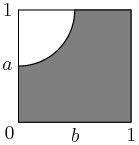

copeland
2015-02-04 19:47:26
What is the area of the succesful region?
What is the area of the succesful region?
ompatel99
2015-02-04 19:48:04
1-pi/16
1-pi/16
Duncanyang
2015-02-04 19:48:04
1-pi/16
1-pi/16
mjoshi
2015-02-04 19:48:04
1-\pi/16
1-\pi/16
mathwrath
2015-02-04 19:48:04
1-pi/16
1-pi/16
Anthrax
2015-02-04 19:48:04
1- 1/4(pi/4)
1- 1/4(pi/4)
BFYSharks
2015-02-04 19:48:04
1-pi/16
1-pi/16
flyrain
2015-02-04 19:48:04
1-pi/16
1-pi/16
alex31415
2015-02-04 19:48:04
1-pi/16
1-pi/16
bharatputra
2015-02-04 19:48:04
1-pi/16
1-pi/16
copeland
2015-02-04 19:48:08
The bad region is a quarter circle with radius 12, so the area of the successful region is 1−π16.
The bad region is a quarter circle with radius 12, so the area of the successful region is 1−π16.
copeland
2015-02-04 19:48:11
What happens if B is chosen on the right side?
What happens if B is chosen on the right side?
BFYSharks
2015-02-04 19:48:28
1
1
mathmass
2015-02-04 19:48:28
1
1
Eridan
2015-02-04 19:48:28
Probability of 1
Probability of 1
poweroftwo
2015-02-04 19:48:28
prob. is 1
prob. is 1
acsigaoyuan
2015-02-04 19:48:28
1
1
bli1999
2015-02-04 19:48:28
probability is 1
probability is 1
DeathLlama9
2015-02-04 19:48:28
1
1
pinkrock
2015-02-04 19:48:28
the probability is 1
the probability is 1
Yumantimatter
2015-02-04 19:48:28
1, and on bottom too
1, and on bottom too
jprogrammer
2015-02-04 19:48:28
1
1
AlcumusGuy
2015-02-04 19:48:28
probability is 1
probability is 1
hliu70
2015-02-04 19:48:28
all points work so 1
all points work so 1
copeland
2015-02-04 19:48:30
This case is easy, B can be anywhere on the right side, so the probability is 1!
This case is easy, B can be anywhere on the right side, so the probability is 1!
copeland
2015-02-04 19:48:30
What happens if B is chosen on the bottom side?
What happens if B is chosen on the bottom side?
Psionic
2015-02-04 19:49:11
same
same
poweroftwo
2015-02-04 19:49:11
same as top
same as top
ACSIXueZiming
2015-02-04 19:49:11
same as the top side
same as the top side
az_phx_brandon_jiang
2015-02-04 19:49:11
same as top
same as top
DeathLlama9
2015-02-04 19:49:11
Same as top
Same as top
jameswangisb
2015-02-04 19:49:11
same as top
same as top
amburger66
2015-02-04 19:49:11
same as if it's on the top side?
same as if it's on the top side?
acsigaoyuan
2015-02-04 19:49:11
same as top side
same as top side
viv7000
2015-02-04 19:49:11
1-pi/16
1-pi/16
richy
2015-02-04 19:49:11
same as top
same as top
bomb427006
2015-02-04 19:49:11
same as top
same as top
yunyun333
2015-02-04 19:49:11
same as top m8
same as top m8
copeland
2015-02-04 19:49:13
This case is symmetric to the top side. The probability is again 1−π16.
This case is symmetric to the top side. The probability is again 1−π16.
copeland
2015-02-04 19:49:17
All right. We've got every case individually, what is the probability?
All right. We've got every case individually, what is the probability?
jigglypuff
2015-02-04 19:50:18
26-pi/32
26-pi/32
TheMaskedMagician
2015-02-04 19:50:18


TigerLily14
2015-02-04 19:50:18
(26-pi)/32
(26-pi)/32
fclvbfm934
2015-02-04 19:50:18
26−π32
26−π32
GU35T-31415
2015-02-04 19:50:18
It is 1/4 times the sum of the individual probabilities because each side is equally likely to be chosen. The probability is (26-pi)/32, so A
It is 1/4 times the sum of the individual probabilities because each side is equally likely to be chosen. The probability is (26-pi)/32, so A
MathStudent2002
2015-02-04 19:50:18
1/2(1-pi/16)+1/4(1)+1/4(1/4)=(26-pi)/32
1/2(1-pi/16)+1/4(1)+1/4(1/4)=(26-pi)/32
copeland
2015-02-04 19:50:21
Since each case occurs with probability 1/4, the total probability is
14(14+2−π8+1)=232+1632−π32+832=26−π32
Since each case occurs with probability 1/4, the total probability is
14(14+2−π8+1)=232+1632−π32+832=26−π32
copeland
2015-02-04 19:50:24
a+b+c is 26+1+32=59 and our answer is (A).
a+b+c is 26+1+32=59 and our answer is (A).
copeland
2015-02-04 19:50:31
Phew!
Phew!
copeland
2015-02-04 19:50:36
All right, we're halfway done by some metric or other. Everyone stand up and spin in a circle really fast.
All right, we're halfway done by some metric or other. Everyone stand up and spin in a circle really fast.
leagueoflanguin
2015-02-04 19:51:04
i will get too dizzy !!!
i will get too dizzy !!!
Psionic
2015-02-04 19:51:04
dizzy!
dizzy!
Destructio
2015-02-04 19:51:04
i is dizzy now
i is dizzy now
kmw2001
2015-02-04 19:51:04
now i am dizzy!
now i am dizzy!
copeland
2015-02-04 19:51:06
Me too. SUCCESS!
Me too. SUCCESS!
copeland
2015-02-04 19:51:11
I'm feeling pretty good - let's keep going.
I'm feeling pretty good - let's keep going.
copeland
2015-02-04 19:51:14
I want to point out a couple of problems that people have mentioned before we move on to the AMC12.
I want to point out a couple of problems that people have mentioned before we move on to the AMC12.
copeland
2015-02-04 19:51:27
On the AMC10 we had this one:
On the AMC10 we had this one:
copeland
2015-02-04 19:51:31
20. A rectangle has area A cm2 and perimeter P cm, where A and P are positive integers. Which of the following numbers cannot equal A+P?
oops
(A) 100 (B) 102 (C) 104 (D) 106 (E) 108
20. A rectangle has area A cm2 and perimeter P cm, where A and P are positive integers. Which of the following numbers cannot equal A+P?
oops
(A) 100 (B) 102 (C) 104 (D) 106 (E) 108
copeland
2015-02-04 19:51:35
As you may know by now, this problem was unfortunately broken. It turns out that all the answer choices are possible values of A+P, because the problem statement forget the words in bold below:
As you may know by now, this problem was unfortunately broken. It turns out that all the answer choices are possible values of A+P, because the problem statement forget the words in bold below:
copeland
2015-02-04 19:51:41
20. A rectangle with integer side lengths (in cm) has area A cm2 and perimeter P cm, where A and P are positive integers. Which of the following numbers cannot equal A+P?
oops
(A) 100 (B) 102 (C) 104 (D) 106 (E) 108
20. A rectangle with integer side lengths (in cm) has area A cm2 and perimeter P cm, where A and P are positive integers. Which of the following numbers cannot equal A+P?
oops
(A) 100 (B) 102 (C) 104 (D) 106 (E) 108
copeland
2015-02-04 19:51:47
If we don't require that the sides have integer lengths, then we can make A+P=n for any even n>4 by letting the sides be 2 and n4−1. Then the area is A=n2−2, and the perimeter is P=2(2+n4−1)=n2+2, so that A+P=n.
If we don't require that the sides have integer lengths, then we can make A+P=n for any even n>4 by letting the sides be 2 and n4−1. Then the area is A=n2−2, and the perimeter is P=2(2+n4−1)=n2+2, so that A+P=n.
copeland
2015-02-04 19:52:01
To solve the intended version of the problem: let the sides be r and s, which we assume are integers. Then n=A+P=rs+2(r+s).
To solve the intended version of the problem: let the sides be r and s, which we assume are integers. Then n=A+P=rs+2(r+s).
copeland
2015-02-04 19:52:09
Adding 4 to both sides invokes Simon's Favorite Factoring Trick:
n+4=rs+2r+2s+4=(r+2)(s+2).
Adding 4 to both sides invokes Simon's Favorite Factoring Trick:
n+4=rs+2r+2s+4=(r+2)(s+2).
copeland
2015-02-04 19:52:15
So n is possible using integer side lengths if and only if n+4 factors into two factors each larger than 2.
So n is possible using integer side lengths if and only if n+4 factors into two factors each larger than 2.
copeland
2015-02-04 19:52:20
All the choices other than (B) work: 104=4⋅26, 108=4⋅27, 110=10⋅11, and 112=4⋅28.
All the choices other than (B) work: 104=4⋅26, 108=4⋅27, 110=10⋅11, and 112=4⋅28.
copeland
2015-02-04 19:52:23
But (B) doesn't work, since 106=2⋅53 and 53 is prime.
But (B) doesn't work, since 106=2⋅53 and 53 is prime.
copeland
2015-02-04 19:52:28
In the original (broken) version of the problem, a rectangle with sides 2 and 24.5 has area 49 and perimeter 53, which sum to 102. In fact, you can pick any reasonable value for A and get whatever large-enough perimeter you want by varying the side lengths.
In the original (broken) version of the problem, a rectangle with sides 2 and 24.5 has area 49 and perimeter 53, which sum to 102. In fact, you can pick any reasonable value for A and get whatever large-enough perimeter you want by varying the side lengths.
droid347
2015-02-04 19:53:18
What is the MAA going to do?
What is the MAA going to do?
wangt
2015-02-04 19:53:18
so what happens to scores???
so what happens to scores???
ompatel99
2015-02-04 19:53:18
What is MAA going to do about this?
What is MAA going to do about this?
mssmath
2015-02-04 19:53:18
What has the MAA decided regarding this problem?
What has the MAA decided regarding this problem?
AlcumusGuy
2015-02-04 19:53:18
What do you think will happen because of this typo/error?
What do you think will happen because of this typo/error?
copeland
2015-02-04 19:53:28
No idea, and I wouldn't want to speculate. I personally think that grading the problem still gives a good indicator of student ability so I would lean toward leaving it in.
No idea, and I wouldn't want to speculate. I personally think that grading the problem still gives a good indicator of student ability so I would lean toward leaving it in.
copeland
2015-02-04 19:53:40
But my opinion isn't worth much. . .
But my opinion isn't worth much. . .
copeland
2015-02-04 19:53:47
We also had 12A Problem 12:
We also had 12A Problem 12:
copeland
2015-02-04 19:53:49
12. The parabolas y=ax2−2 and y=4−bx2 intersect the coordinate axes in exactly 4 points, and these four points are the vertices of a kite of area 12. What is a+b?
oops
(A) 1 (B) 1.5 (C) 2 (D) 2.5 (E) 3
12. The parabolas y=ax2−2 and y=4−bx2 intersect the coordinate axes in exactly 4 points, and these four points are the vertices of a kite of area 12. What is a+b?
oops
(A) 1 (B) 1.5 (C) 2 (D) 2.5 (E) 3
copeland
2015-02-04 19:53:51
This problem is expecting you to draw this:
This problem is expecting you to draw this:
copeland
2015-02-04 19:53:57
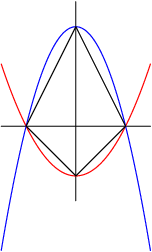

copeland
2015-02-04 19:54:03
But. . .
But. . .
2015WOOTer
2015-02-04 19:54:29
ohh, a, b>0, right?
ohh, a, b>0, right?
ryanyoo
2015-02-04 19:54:29
a and b could be negatives
a and b could be negatives
copeland
2015-02-04 19:54:31
However, there is an issue that you could have either a or b negative, like:
However, there is an issue that you could have either a or b negative, like:
copeland
2015-02-04 19:54:34
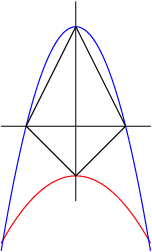

copeland
2015-02-04 19:54:35
And still have 4 intersections.
And still have 4 intersections.
copeland
2015-02-04 19:54:45
I found that if you notice the error here, you probably made the right course-correction pretty quickly. If either one is negative the largest value you can only get numbers less than 1 for a+b so of the choices given, only 1.5 is even reasonable.
I found that if you notice the error here, you probably made the right course-correction pretty quickly. If either one is negative the largest value you can only get numbers less than 1 for a+b so of the choices given, only 1.5 is even reasonable.
copeland
2015-02-04 19:54:58
The fix for this problem is probably to say that a and b are positive. I would bet that the real sentiment, though, was more like:
The fix for this problem is probably to say that a and b are positive. I would bet that the real sentiment, though, was more like:
copeland
2015-02-04 19:55:02
12. The parabolas y=ax2−2 and y=4−bx2 intersect on the x-axis and intersect the coordinate axes in exactly 4 points. These four points are the vertices of a kite of area 12. What is a+b?
oops
(A) 1 (B) 1.5 (C) 2 (D) 2.5 (E) 3
12. The parabolas y=ax2−2 and y=4−bx2 intersect on the x-axis and intersect the coordinate axes in exactly 4 points. These four points are the vertices of a kite of area 12. What is a+b?
oops
(A) 1 (B) 1.5 (C) 2 (D) 2.5 (E) 3
hibiscus
2015-02-04 19:55:52
Does MAA usually make mistakes like this?
Does MAA usually make mistakes like this?
copeland
2015-02-04 19:55:55
Writing a test is REALLY HARD. I've written problems with errors before. You feel really bad about it. After all, you're trying to make something that is fun math for people.
Writing a test is REALLY HARD. I've written problems with errors before. You feel really bad about it. After all, you're trying to make something that is fun math for people.
copeland
2015-02-04 19:56:15
Let's move on. . .
Let's move on. . .
copeland
2015-02-04 19:56:23
21. A circle of radius r passes through both foci of, and exactly four points on, the ellipse with equation x2+16y2=16. The set of all possible values of r is an interval [a,b). What is a+b?
Hi!
(A) 5√2+4 (B) √17+7 (C) 6√2+3 (D) √15+8 (E) 12
21. A circle of radius r passes through both foci of, and exactly four points on, the ellipse with equation x2+16y2=16. The set of all possible values of r is an interval [a,b). What is a+b?
Hi!
(A) 5√2+4 (B) √17+7 (C) 6√2+3 (D) √15+8 (E) 12
copeland
2015-02-04 19:56:26
First off, what does that notation [a,b) mean?
First off, what does that notation [a,b) mean?
2015WOOTer
2015-02-04 19:57:00
it means a≤x<b
it means a≤x<b
FractalMathHistory
2015-02-04 19:57:00
a is inclusive, b is exclusive
a is inclusive, b is exclusive
acsigaoyuan
2015-02-04 19:57:00
a<=r<b
a<=r<b
codyj
2015-02-04 19:57:00
a≤r<b
a≤r<b
Duncanyang
2015-02-04 19:57:00
a <= x < b
a <= x < b
thatmathgeek
2015-02-04 19:57:00
a <= ... < b
a <= ... < b
2015WOOTer
2015-02-04 19:57:00
it means a≤r<b
it means a≤r<b
copeland
2015-02-04 19:57:03
It means that the possible values of r satisfy a≤r<b. The bracket at the a end means that we include a, but the parenthesis at the b end means we don't include b.
It means that the possible values of r satisfy a≤r<b. The bracket at the a end means that we include a, but the parenthesis at the b end means we don't include b.
copeland
2015-02-04 19:57:09
OH:
OH:
Anthrax
2015-02-04 19:57:11
Are we on 12A now?
Are we on 12A now?
Gwena
2015-02-04 19:57:11
Is this for the AMC 12?
Is this for the AMC 12?
copeland
2015-02-04 19:57:15
Yes. On to the AMC12.
Yes. On to the AMC12.
copeland
2015-02-04 19:57:22
Let's start by sketching the ellipse. How?
Let's start by sketching the ellipse. How?
zsp
2015-02-04 19:57:59
Draw x = 0 and y = 0
Draw x = 0 and y = 0
armalite46
2015-02-04 19:57:59
major axes 4 minor axes 1
major axes 4 minor axes 1
hnkevin42
2015-02-04 19:57:59
Find the x and y-intercepts
Find the x and y-intercepts
alex31415
2015-02-04 19:57:59
The vertices are (0,1), (0,-1), (4,0), (-4,0)
The vertices are (0,1), (0,-1), (4,0), (-4,0)
lucylai
2015-02-04 19:57:59
it goes through (0,1),(0,-1),(4,0),(-4,0)
it goes through (0,1),(0,-1),(4,0),(-4,0)
ninjataco
2015-02-04 19:57:59
centered at (0,0) horizontal axis length 8 and vertical axis length 2
centered at (0,0) horizontal axis length 8 and vertical axis length 2
copeland
2015-02-04 19:58:10
Let's look where it cross the axes.
Let's look where it cross the axes.
copeland
2015-02-04 19:58:12
It passes through (±4,0) and (0,±1). So it looks something like this:
It passes through (±4,0) and (0,±1). So it looks something like this:
copeland
2015-02-04 19:58:15
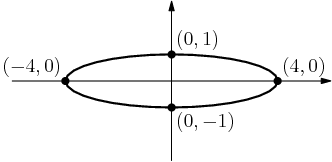

copeland
2015-02-04 19:58:15
Now what?
Now what?
TheMaskedMagician
2015-02-04 19:58:29
Find the foci
Find the foci
mathymath
2015-02-04 19:58:29
Foci
Foci
skimisgod
2015-02-04 19:58:29
Find the foci
Find the foci
kcui
2015-02-04 19:58:29
the foci!
the foci!
acsigaoyuan
2015-02-04 19:58:29
Find the foci
Find the foci
abvenkgoo
2015-02-04 19:58:29
fidn the foci
fidn the foci
ACSIXueZiming
2015-02-04 19:58:29
find the foci
find the foci
eswa2000
2015-02-04 19:58:29
find the foci
find the foci
copeland
2015-02-04 19:58:31
We should probably find the foci, since all of our potential circles have to pass through the foci too.
We should probably find the foci, since all of our potential circles have to pass through the foci too.
copeland
2015-02-04 19:58:32
Wait, what are "foci"?
Wait, what are "foci"?
copeland
2015-02-04 19:58:39
Foci are focuses.
Foci are focuses.
copeland
2015-02-04 19:58:47
Maybe "Foci is focuses." I don't know.
Maybe "Foci is focuses." I don't know.
2015WOOTer
2015-02-04 19:59:19
we can find foci with the foci-distance equation
we can find foci with the foci-distance equation
flyrain
2015-02-04 19:59:19
the points such that the sum of the distances to the foci is same for every point on the ellipse
the points such that the sum of the distances to the foci is same for every point on the ellipse
Anthrax
2015-02-04 19:59:19
Points where the distance from one focus to the ellipse to the other focus is constant
Points where the distance from one focus to the ellipse to the other focus is constant
MathStudent2002
2015-02-04 19:59:19
the sum of the distances to the foci is constant iirc
the sum of the distances to the foci is constant iirc
CreativeNinja
2015-02-04 19:59:21
focus on the foci
focus on the foci
copeland
2015-02-04 19:59:24
One way to describe an ellipse is as all the points for which the sum of the distance to two foci is constant. (This is similar to a circle, in which the distance to a single point -- called the "center" -- is constant. A circle is also an ellipse where the foci are the same point.)
One way to describe an ellipse is as all the points for which the sum of the distance to two foci is constant. (This is similar to a circle, in which the distance to a single point -- called the "center" -- is constant. A circle is also an ellipse where the foci are the same point.)
copeland
2015-02-04 19:59:26
The foci always lie at symmetric positions along the longer axis. So in our particular example, they lie at (±f,0) for some f. And the total blue distance below is constant for any point on the ellipse:
The foci always lie at symmetric positions along the longer axis. So in our particular example, they lie at (±f,0) for some f. And the total blue distance below is constant for any point on the ellipse:
copeland
2015-02-04 19:59:30
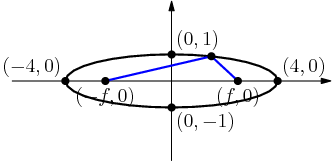

copeland
2015-02-04 19:59:30
But the point I chose as my example was a pretty dumb one. What's a smarter choice?
But the point I chose as my example was a pretty dumb one. What's a smarter choice?
lucylai
2015-02-04 20:00:10
(4,0) and (0,1)
(4,0) and (0,1)
ninjataco
2015-02-04 20:00:10
(4,0)
(4,0)
Doink
2015-02-04 20:00:10
(4,0)
(4,0)
zsp
2015-02-04 20:00:10
4, 0
4, 0
Picroft
2015-02-04 20:00:10
4,0
4,0
Studiosa
2015-02-04 20:00:10
(4,0)
(4,0)
BFYSharks
2015-02-04 20:00:10
(0,1) or (4,0)
(0,1) or (4,0)
acsigaoyuan
2015-02-04 20:00:11
(4,0)
(4,0)
copeland
2015-02-04 20:00:13
How about (4,0)?
How about (4,0)?
copeland
2015-02-04 20:00:15
What is the total blue distance from (4,0) to the two foci?
What is the total blue distance from (4,0) to the two foci?
copeland
2015-02-04 20:00:15
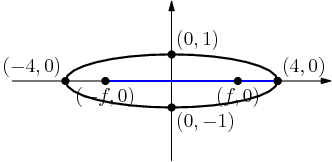

sahilp
2015-02-04 20:00:38
8
8
jigglypuff
2015-02-04 20:00:38
8
8
GU35T-31415
2015-02-04 20:00:38
8
8
jkyman
2015-02-04 20:00:38
8
8
verum4one
2015-02-04 20:00:38
8
8
Psionic
2015-02-04 20:00:38
8
8
aopsish
2015-02-04 20:00:38
f+4 + (4-f) = 8
f+4 + (4-f) = 8
copeland
2015-02-04 20:00:40
The distance to the right focus is 4−f.
The distance to the left focus is 4+f.
So the total distance is 8.
The distance to the right focus is 4−f.
The distance to the left focus is 4+f.
So the total distance is 8.
copeland
2015-02-04 20:00:43
This means that for any point on the ellipse, the total blue distance is 8.
This means that for any point on the ellipse, the total blue distance is 8.
copeland
2015-02-04 20:00:44
So what?
So what?
copeland
2015-02-04 20:00:51
Oh, we wanted to do another one!
Oh, we wanted to do another one!
copeland
2015-02-04 20:00:57
Let's use the point (0,1) as our example point:
Let's use the point (0,1) as our example point:
copeland
2015-02-04 20:00:59
What's the total blue distance now?
What's the total blue distance now?
copeland
2015-02-04 20:01:00
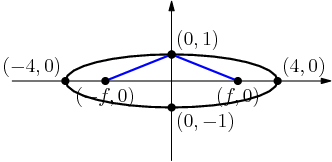

MathStudent2002
2015-02-04 20:01:38
The distance from (f,0) to (0,1) is 8/2=4, so our f is sqrt(15)
The distance from (f,0) to (0,1) is 8/2=4, so our f is sqrt(15)
lucylai
2015-02-04 20:01:38
2sqrt(f^2+1)
2sqrt(f^2+1)
acsigaoyuan
2015-02-04 20:01:38
2*sqrt(1+f^2)
2*sqrt(1+f^2)
ACSIXueZiming
2015-02-04 20:01:38
2 sqrt(f^2+1)
2 sqrt(f^2+1)
BFYSharks
2015-02-04 20:01:38
2√1+f2
2√1+f2
yimingz89
2015-02-04 20:01:38
2sqrt(f^2+1)=8
2sqrt(f^2+1)=8
pedronr
2015-02-04 20:01:38
2√1+f2
2√1+f2
verum4one
2015-02-04 20:01:38
2√1+f2
2√1+f2
jameswangisb
2015-02-04 20:01:38
2(root(f^2+1))
2(root(f^2+1))
copeland
2015-02-04 20:01:41
Each blue segment, by the Pythagorean Theorem, is √f2+1.
Each blue segment, by the Pythagorean Theorem, is √f2+1.
copeland
2015-02-04 20:01:42
So the total blue distance is 2√f2+1, and this must equal 8.
So the total blue distance is 2√f2+1, and this must equal 8.
copeland
2015-02-04 20:01:46
This means √f2+1=4, so f2+1=16, and thus f=√15.
This means √f2+1=4, so f2+1=16, and thus f=√15.
copeland
2015-02-04 20:01:53
So the foci are at (±√15,0).
So the foci are at (±√15,0).
copeland
2015-02-04 20:01:55
My picture isn't very close to scale, so let's fix it up:
My picture isn't very close to scale, so let's fix it up:
copeland
2015-02-04 20:01:57
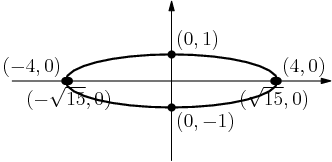

copeland
2015-02-04 20:02:01
Well...maybe that's too much to scale to be useful. So let's cheat a little and make it more readable:
Well...maybe that's too much to scale to be useful. So let's cheat a little and make it more readable:
hnkevin42
2015-02-04 20:02:10
whoa. they're close.
whoa. they're close.
Duncanyang
2015-02-04 20:02:10
wow so close
wow so close
copeland
2015-02-04 20:02:16
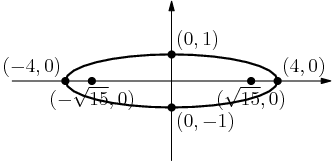

copeland
2015-02-04 20:02:28
OK, now what?
OK, now what?
copeland
2015-02-04 20:02:28
What's the smallest circle that could possibly contain both foci and also 4 points on the ellipse?
What's the smallest circle that could possibly contain both foci and also 4 points on the ellipse?
blueberry7
2015-02-04 20:03:11
x^2+y^2=15
x^2+y^2=15
Jayjayliu
2015-02-04 20:03:11
One with radius sqrt(15)
One with radius sqrt(15)
zsp
2015-02-04 20:03:11
origin circle with radius sqrt15
origin circle with radius sqrt15
acsigaoyuan
2015-02-04 20:03:11
diameter is between two foci
diameter is between two foci
mathtastic
2015-02-04 20:03:11
one centered at the origin
one centered at the origin
Yumantimatter
2015-02-04 20:03:11
r=sqrt(15)
r=sqrt(15)
happyhummingbird
2015-02-04 20:03:11
radius = sqrt(15)
radius = sqrt(15)
zacchro
2015-02-04 20:03:11
the one with radius √15
the one with radius √15
tanuagg13
2015-02-04 20:03:11
circle with radius root15 centered at origin
circle with radius root15 centered at origin
yajaniaj
2015-02-04 20:03:11
diameter of 2sqrt(15)
diameter of 2sqrt(15)
fractal161
2015-02-04 20:03:11
Circle of radius sqrt(15)
Circle of radius sqrt(15)
bomb427006
2015-02-04 20:03:11
x^2+y^2=15
x^2+y^2=15
GU35T-31415
2015-02-04 20:03:11
The one with the foci as endpoints of a diameter
The one with the foci as endpoints of a diameter
nebulagirl
2015-02-04 20:03:11
r = sqrt(15)
r = sqrt(15)
copeland
2015-02-04 20:03:28
Note that the segment connecting the foci has to be a chord of our circle. So we want the smallest circle that contains a chord of length 2√15.
Note that the segment connecting the foci has to be a chord of our circle. So we want the smallest circle that contains a chord of length 2√15.
copeland
2015-02-04 20:03:32
It's the circle with diameter 2√15 --- any circle that's smaller won't have a big enough chord.
It's the circle with diameter 2√15 --- any circle that's smaller won't have a big enough chord.
copeland
2015-02-04 20:03:33
So the smallest possible radius is a=√15:
So the smallest possible radius is a=√15:
copeland
2015-02-04 20:03:36
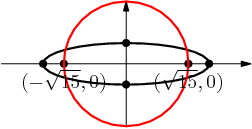

copeland
2015-02-04 20:03:38
(Note that the circle clearly intersects the ellipse at 4 points, so we're OK.)
(Note that the circle clearly intersects the ellipse at 4 points, so we're OK.)
copeland
2015-02-04 20:04:01
We notice 2 things:
We notice 2 things:
Yumantimatter
2015-02-04 20:04:03
looks like Saturn!
looks like Saturn!
hjl00
2015-02-04 20:04:03
that looks like saturn
that looks like saturn
flyrain
2015-02-04 20:04:03
looks like saturn
looks like saturn
copeland
2015-02-04 20:04:07
and. . .
and. . .
treemath
2015-02-04 20:04:12
already we see the answer is D
already we see the answer is D
hnkevin42
2015-02-04 20:04:12
only one of our answer choices contains sqrt(15)...
only one of our answer choices contains sqrt(15)...
copeland
2015-02-04 20:04:15
At this point, we know the answer is √15+b, where b is the upper bound of the radius of the circle.
At this point, we know the answer is √15+b, where b is the upper bound of the radius of the circle.
copeland
2015-02-04 20:04:26
Looking at the answer choices, I'd be very, very tempted to mark (D), since that's the only choice that has a √15 term. Otherwise, you'd have to believe that there's going to be a −√15 in b to cancel it out, which seems unlikely.
Looking at the answer choices, I'd be very, very tempted to mark (D), since that's the only choice that has a √15 term. Otherwise, you'd have to believe that there's going to be a −√15 in b to cancel it out, which seems unlikely.
copeland
2015-02-04 20:04:27
In fact, (D) is the answer! But let's see how we get b=8 to be our upper bound.
In fact, (D) is the answer! But let's see how we get b=8 to be our upper bound.
copeland
2015-02-04 20:04:30
What do we know about a circle that passes through both of (±√15,0)?
What do we know about a circle that passes through both of (±√15,0)?
swirlykick
2015-02-04 20:05:07
Its center is on the y axis
Its center is on the y axis
tiger21
2015-02-04 20:05:07
its center is on the y axis
its center is on the y axis
cellobix
2015-02-04 20:05:07
It is on the y-axis
It is on the y-axis
fractal161
2015-02-04 20:05:07
It has center on the y-axis.
It has center on the y-axis.
jigglypuff
2015-02-04 20:05:07
centered on y axis
centered on y axis
Doink
2015-02-04 20:05:07
its center lies on the y-axis
its center lies on the y-axis
kaz74
2015-02-04 20:05:07
Center is on the y axis
Center is on the y axis
copeland
2015-02-04 20:05:09
Its center must be on the y-axis.
Its center must be on the y-axis.
copeland
2015-02-04 20:05:10
Specifically, if such a circle is centered at (0,y), then the radius is √y2+15.
Specifically, if such a circle is centered at (0,y), then the radius is √y2+15.
copeland
2015-02-04 20:05:38
How can such a circle fail to intersect the ellipse in 4 points?
How can such a circle fail to intersect the ellipse in 4 points?
Hyperspace01
2015-02-04 20:06:29
if it touches the bottom or top of the ellipse in one point
if it touches the bottom or top of the ellipse in one point
az_phx_brandon_jiang
2015-02-04 20:06:29
tangent at the point (0,+-1)
tangent at the point (0,+-1)
ninjataco
2015-02-04 20:06:29
if it is above/below the ellipse
if it is above/below the ellipse
Kevin100
2015-02-04 20:06:29
if it only touches 3 points, such as if it hits "the bottom" of the ellipse
if it only touches 3 points, such as if it hits "the bottom" of the ellipse
kcui
2015-02-04 20:06:29
if it is tangent to the top or bottom of the ellipse
if it is tangent to the top or bottom of the ellipse
smith_ch
2015-02-04 20:06:29
radius is not long enough to reach the bottom part of the elipse, so it only intersects in 2 points.
radius is not long enough to reach the bottom part of the elipse, so it only intersects in 2 points.
wlpj11
2015-02-04 20:06:29
it is centered to high or to low
it is centered to high or to low
awesomemathlete
2015-02-04 20:06:29
tangent to ellipse
tangent to ellipse
copeland
2015-02-04 20:06:31
If it doesn't get "low enough" to reach the bottom half of the ellipse, like so:
If it doesn't get "low enough" to reach the bottom half of the ellipse, like so:
copeland
2015-02-04 20:06:33
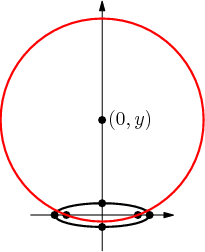

copeland
2015-02-04 20:06:34
But what's the point at which the bottom of the circle crosses the y-axis?
But what's the point at which the bottom of the circle crosses the y-axis?
cellobix
2015-02-04 20:07:38
y - sqrt(y^2 + 15)
y - sqrt(y^2 + 15)
eswa2000
2015-02-04 20:07:38
(0, y-r)
(0, y-r)
verum4one
2015-02-04 20:07:38
(0,y−√y2+15)
(0,y−√y2+15)
ACSIXueZiming
2015-02-04 20:07:38
0,y-r
0,y-r
acsigaoyuan
2015-02-04 20:07:38
y-sqrt(y^2+15)
y-sqrt(y^2+15)
Anthrax
2015-02-04 20:07:38
(0, y-r)
(0, y-r)
kameswari
2015-02-04 20:07:38
y minus the radius?
y minus the radius?
copeland
2015-02-04 20:07:40
It's the point (0,y−√y2+15).
It's the point (0,y−√y2+15).
copeland
2015-02-04 20:07:42
So for the circle to be "low enough" to work, we must have y−√y2+15<−1.
So for the circle to be "low enough" to work, we must have y−√y2+15<−1.
copeland
2015-02-04 20:07:48
This rearranges to give y+1<√y2+15.
This rearranges to give y+1<√y2+15.
copeland
2015-02-04 20:07:50
Since y>0, it's safe to square both sides to get y2+2y+1<y2+15.
Since y>0, it's safe to square both sides to get y2+2y+1<y2+15.
copeland
2015-02-04 20:07:54
Hence 2y<14, or y<7.
Hence 2y<14, or y<7.
copeland
2015-02-04 20:08:07
And when y<7, the radius is √y2+15<√49+15=√64=8.
And when y<7, the radius is √y2+15<√49+15=√64=8.
ACSIXueZiming
2015-02-04 20:08:35
sqrt 15 +8
sqrt 15 +8
pedronr
2015-02-04 20:08:35
or 7+1
or 7+1
Duncanyang
2015-02-04 20:08:35
"D" IS THE ANSWER
"D" IS THE ANSWER
copeland
2015-02-04 20:08:38
So the radius must be in the interval [√15,8) for the circle to work, and hence the answer is (D).
So the radius must be in the interval [√15,8) for the circle to work, and hence the answer is (D).
copeland
2015-02-04 20:08:51
Cool.
Cool.
mango99
2015-02-04 20:09:03
that was a really looong solution
that was a really looong solution
copeland
2015-02-04 20:09:04
You ain't seen nothing yet.
You ain't seen nothing yet.
copeland
2015-02-04 20:09:14
22. For each positive integer n, let S(n) be the number of sequences of length n consisting solely of the letters A and B, with no more than three As in a row and no more than three Bs in a row. What is the remainder when S(2015) is divided by 12?
peekaboo!
(A) 0(B) 4(C) 6(D) 8(E) 10
22. For each positive integer n, let S(n) be the number of sequences of length n consisting solely of the letters A and B, with no more than three As in a row and no more than three Bs in a row. What is the remainder when S(2015) is divided by 12?
peekaboo!
(A) 0(B) 4(C) 6(D) 8(E) 10
copeland
2015-02-04 20:09:19
I had a lot of great false-starts on this problem. My trouble was that I forgot the most important technique for solving contest problems. . .
I had a lot of great false-starts on this problem. My trouble was that I forgot the most important technique for solving contest problems. . .
Psionic
2015-02-04 20:09:43
DO SOMETHING
DO SOMETHING
2015WOOTer
2015-02-04 20:09:43
small values!!
small values!!
jigglypuff
2015-02-04 20:09:43
small cases
small cases
az_phx_brandon_jiang
2015-02-04 20:09:43
list out small cases?
list out small cases?
TheMaskedMagician
2015-02-04 20:09:43
do stupid things?
do stupid things?
ninjataco
2015-02-04 20:09:43
try small cases?
try small cases?
Psionic
2015-02-04 20:09:43
look for a pattern
look for a pattern
hnkevin42
2015-02-04 20:09:43
start small.
start small.
MathStudent2002
2015-02-04 20:09:43
Let's try some small values of n to see if we can find something
Let's try some small values of n to see if we can find something
copeland
2015-02-04 20:09:46
Thank you.
Thank you.
copeland
2015-02-04 20:09:48
Try small cases.
Try small cases.
copeland
2015-02-04 20:09:49
What is S(1)?
What is S(1)?
BFYSharks
2015-02-04 20:10:01
2
2
bobispro5
2015-02-04 20:10:01
2
2
hnkevin42
2015-02-04 20:10:01
2.
2.
mathwrath
2015-02-04 20:10:01
2
2
lucylai
2015-02-04 20:10:01
2
2
wangt
2015-02-04 20:10:01
2
2
abvenkgoo
2015-02-04 20:10:01
2
2
Jayjayliu
2015-02-04 20:10:01
2
2
Yumantimatter
2015-02-04 20:10:01
2
2
tanuagg13
2015-02-04 20:10:01
2
2
Jayjayliu
2015-02-04 20:10:01
2
2
copeland
2015-02-04 20:10:03
S(1)=2. We can either write A or B.
S(1)=2. We can either write A or B.
copeland
2015-02-04 20:10:04
What is S(2)?
What is S(2)?
ompatel99
2015-02-04 20:10:15
4
4
bli1999
2015-02-04 20:10:15
4
4
eddy55
2015-02-04 20:10:15
4
4
Superwiz
2015-02-04 20:10:15
4
4
Abecissa
2015-02-04 20:10:15
4
4
yunyun333
2015-02-04 20:10:15
4
4
bubblebee412
2015-02-04 20:10:15
4
4
legolego
2015-02-04 20:10:15
4
4
bomb427006
2015-02-04 20:10:15
4
4
copeland
2015-02-04 20:10:17
S(2)=4. We can have {AA,AB,BA,BB}.
S(2)=4. We can have {AA,AB,BA,BB}.
copeland
2015-02-04 20:10:18
What is S(3)?
What is S(3)?
zsp
2015-02-04 20:10:36
8
8
Yumantimatter
2015-02-04 20:10:36
8
8
happyhummingbird
2015-02-04 20:10:36
8
8
yunyun333
2015-02-04 20:10:36
8
8
Duncanyang
2015-02-04 20:10:36
8
8
kaz74
2015-02-04 20:10:36
8
8
Hyperspace01
2015-02-04 20:10:36
8
8
Psionic
2015-02-04 20:10:36
8
8
skimisgod
2015-02-04 20:10:36
8
8
yajaniaj
2015-02-04 20:10:36
8
8
copeland
2015-02-04 20:10:38
S(3)=8. We can have {AAA,AAB,ABA,ABB,BAA,BAB,BBA,BBB}.
S(3)=8. We can have {AAA,AAB,ABA,ABB,BAA,BAB,BBA,BBB}.
copeland
2015-02-04 20:10:39
OK, so S(n)=2n. Clearly.
OK, so S(n)=2n. Clearly.
copeland
2015-02-04 20:10:43
No. . . that's wrong. You can usually put A at the end, unless you already have 3 As to begin with.
No. . . that's wrong. You can usually put A at the end, unless you already have 3 As to begin with.
copeland
2015-02-04 20:10:50
Wait, there's an even deeper problem. There's a problem with naive recursion in that we can't just chop off the last character and talk in terms of S(n−1). Is there something we can do?
Wait, there's an even deeper problem. There's a problem with naive recursion in that we can't just chop off the last character and talk in terms of S(n−1). Is there something we can do?
dsyff
2015-02-04 20:12:05
cases
cases
AlcumusGuy
2015-02-04 20:12:05
include earlier terms in the recursion
include earlier terms in the recursion
copeland
2015-02-04 20:12:10
How?
How?
copeland
2015-02-04 20:12:30
How many different flavors of sequences are there? What certain ways can they end?
How many different flavors of sequences are there? What certain ways can they end?
retrovirus721
2015-02-04 20:13:14
number of A's multiply by 2 for B
number of A's multiply by 2 for B
Dukejukem
2015-02-04 20:13:14
Define T(n) as the number of sequences with length n, such that no three A's or B's are in a row, and the sequence ends in either two A's or two B's. Then define R(n) as the number of sequences of length n, such that no three A's or B's are in a row, and the sequence ends in a single A or B. Then S(n)=T(n - 1) + 2R(n - 1).$ We can also find recur
Define T(n) as the number of sequences with length n, such that no three A's or B's are in a row, and the sequence ends in either two A's or two B's. Then define R(n) as the number of sequences of length n, such that no three A's or B's are in a row, and the sequence ends in a single A or B. Then S(n)=T(n - 1) + 2R(n - 1).$ We can also find recur
alex31415
2015-02-04 20:13:14
A, AA, AAA, similar for B
A, AA, AAA, similar for B
cellobix
2015-02-04 20:13:14
3 in a row, 2 in a row, 1 in a row
3 in a row, 2 in a row, 1 in a row
acsigaoyuan
2015-02-04 20:13:14
end in 1, 2 or 3 consecutive letters
end in 1, 2 or 3 consecutive letters
Studiosa
2015-02-04 20:13:14
A, AA, AAA, B, BB, BBB -- 6 possible endings
A, AA, AAA, B, BB, BBB -- 6 possible endings
mssmath
2015-02-04 20:13:14
A,AA,AAA,B,BB,BBB
A,AA,AAA,B,BB,BBB
az_phx_brandon_jiang
2015-02-04 20:13:14
end in 0,1, or 2A's or 0, 1, or 2 B's
end in 0,1, or 2A's or 0, 1, or 2 B's
copeland
2015-02-04 20:13:25
We could instead chop off the last block of equal characters!
We could instead chop off the last block of equal characters!
copeland
2015-02-04 20:13:31
We can get a valid string by taking any string of length n and deleting as many identical characters as possible from the end of the string (1, 2, or 3).
We can get a valid string by taking any string of length n and deleting as many identical characters as possible from the end of the string (1, 2, or 3).
copeland
2015-02-04 20:13:38
Therefore the strings of length n ends in one of three ways:
* [⋯BA] A single character of some parity following a string of length n−1 that ends in the opposite parity
* [⋯BAA] Two characters of some parity following a string of length n−2 that ends in the opposite parity
* [⋯BAAA] Three characters of some parity following a string of length n−3 that ends in the opposite parity
Therefore the strings of length n ends in one of three ways:
* [⋯BA] A single character of some parity following a string of length n−1 that ends in the opposite parity
* [⋯BAA] Two characters of some parity following a string of length n−2 that ends in the opposite parity
* [⋯BAAA] Three characters of some parity following a string of length n−3 that ends in the opposite parity
copeland
2015-02-04 20:13:54
Deleting as many identical characters as possible from the end of each of our strings of length n gives a bijection between the set of strings of length n and the union of the sets of strings of length n−1, n−2, and n−3.
Deleting as many identical characters as possible from the end of each of our strings of length n gives a bijection between the set of strings of length n and the union of the sets of strings of length n−1, n−2, and n−3.
copeland
2015-02-04 20:14:24
What recursive formula does that give us?
What recursive formula does that give us?
flyrain
2015-02-04 20:15:07
Tribonnaci
Tribonnaci
Psionic
2015-02-04 20:15:07
so S(n) = S(n-1) + S(n-2) + S(n-3)
so S(n) = S(n-1) + S(n-2) + S(n-3)
az_phx_brandon_jiang
2015-02-04 20:15:07
S(n)=S(n-1)+S(n-2)+S(n-3)
S(n)=S(n-1)+S(n-2)+S(n-3)
flyrain
2015-02-04 20:15:07
S(n)=S(n-1)+S(n-2)+S(n-3)
S(n)=S(n-1)+S(n-2)+S(n-3)
lucylai
2015-02-04 20:15:07
S(n)=S(n-1)+S(n-2)+S(n-3)
S(n)=S(n-1)+S(n-2)+S(n-3)
Dukejukem
2015-02-04 20:15:07
It ends up being Fibonacci-esque I'm pretty sure
It ends up being Fibonacci-esque I'm pretty sure
danusv
2015-02-04 20:15:07
S(n)=S(n-1)+S(n-2)+S(n-3)
S(n)=S(n-1)+S(n-2)+S(n-3)
amor13
2015-02-04 20:15:07
s(n) = s(n-1) + s(n-2) + s(n-3)
s(n) = s(n-1) + s(n-2) + s(n-3)
bobispro5
2015-02-04 20:15:07
s=s_n-1+s_n-2+s_n-3
s=s_n-1+s_n-2+s_n-3
acsigaoyuan
2015-02-04 20:15:07
S(n)=2S(n-1)+2S(n-2)+S(n-3)
S(n)=2S(n-1)+2S(n-2)+S(n-3)
swirlykick
2015-02-04 20:15:07
S(n)=s(n-1)+s(n-2)+s(n-3)?
S(n)=s(n-1)+s(n-2)+s(n-3)?
eswa2000
2015-02-04 20:15:07


wehac
2015-02-04 20:15:07
s(n)=s(n-3)+s(n-2)+s(n-1)
s(n)=s(n-3)+s(n-2)+s(n-1)
copeland
2015-02-04 20:15:10
This tells us that
This tells us that
copeland
2015-02-04 20:15:11
S(n)=S(n−1)+S(n−2)+S(n−3).
S(n)=S(n−1)+S(n−2)+S(n−3).
copeland
2015-02-04 20:15:14
Now we just start listing. Fortunately we computed the first three already.
Now we just start listing. Fortunately we computed the first three already.
copeland
2015-02-04 20:15:17
n12345S(n)2481426
n12345S(n)2481426
copeland
2015-02-04 20:15:22
Oops. We only want that modulo 12. Let's try again:
Oops. We only want that modulo 12. Let's try again:
copeland
2015-02-04 20:15:24
n123456789101112131415161718S(n)(mod12)2482204610806284228
n123456789101112131415161718S(n)(mod12)2482204610806284228
copeland
2015-02-04 20:15:31
And when I was working the test myself I got even further than this before saying to myself, "Jeremy, what you are doing is stupid."
And when I was working the test myself I got even further than this before saying to myself, "Jeremy, what you are doing is stupid."
copeland
2015-02-04 20:15:38
What is the right way to do this?
What is the right way to do this?
mssmath
2015-02-04 20:16:13
Take mod 3 and mod 4 is easier
Take mod 3 and mod 4 is easier
lucylai
2015-02-04 20:16:13
mod 3 and mod 4
mod 3 and mod 4
tanuagg13
2015-02-04 20:16:13
mod 3, mod 4
mod 3, mod 4
danusv
2015-02-04 20:16:13
mod 3 and mod 4 and then use CRT
mod 3 and mod 4 and then use CRT
hnkevin42
2015-02-04 20:16:13
split it up into mod 3 and mod 4
split it up into mod 3 and mod 4
Special_K
2015-02-04 20:16:13
mod 3 and mod 4
mod 3 and mod 4
Hydroxide
2015-02-04 20:16:13
Take mod 3 and mod 4
Take mod 3 and mod 4
awesomemathlete
2015-02-04 20:16:13
remainders modulo 3 and 4
remainders modulo 3 and 4
copeland
2015-02-04 20:16:16
Of course we want the Chinese Remainder Theorem. We should look at the sequence modulo 3 and 4 separately and see what happens. What is the period modulo 3?
Of course we want the Chinese Remainder Theorem. We should look at the sequence modulo 3 and 4 separately and see what happens. What is the period modulo 3?
awesomemathlete
2015-02-04 20:17:20
13
13
Hydroxide
2015-02-04 20:17:20
13
13
awesomemathlete
2015-02-04 20:17:20
the period is 13 modulo 3
the period is 13 modulo 3
lucylai
2015-02-04 20:17:20
1,2,1,1,1,0,2,0,2,1,0,0,1 => period is 13
1,2,1,1,1,0,2,0,2,1,0,0,1 => period is 13
acsigaoyuan
2015-02-04 20:17:20
13
13
ompatel99
2015-02-04 20:17:20
13
13
zacchro
2015-02-04 20:17:20
13
13
copeland
2015-02-04 20:17:23
n123456789101112131415161718S(n)(mod3)212220101200221222
n123456789101112131415161718S(n)(mod3)212220101200221222
copeland
2015-02-04 20:17:26
We've hit a block of 3 that repeats (212). Since there are 3 terms to the recursion that tells us that we have to start repeating here.
We've hit a block of 3 that repeats (212). Since there are 3 terms to the recursion that tells us that we have to start repeating here.
copeland
2015-02-04 20:17:32
The period modulo 3 is 13. What is the period modulo 4?
The period modulo 3 is 13. What is the period modulo 4?
acsigaoyuan
2015-02-04 20:18:09
4
4
zacchro
2015-02-04 20:18:09
4
4
lucylai
2015-02-04 20:18:09
4
4
apple.singer
2015-02-04 20:18:09
it's 4
it's 4
ompatel99
2015-02-04 20:18:09
4
4
pedronr
2015-02-04 20:18:09
4
4
verum4one
2015-02-04 20:18:09
4
4
Psionic
2015-02-04 20:18:09
4
4
copeland
2015-02-04 20:18:11
n123456789101112131415161718S(n)(mod4)200220022002200220
n123456789101112131415161718S(n)(mod4)200220022002200220
copeland
2015-02-04 20:18:12
The period is 4.
The period is 4.
niraekjs
2015-02-04 20:18:19
You can also do it mod 12, but that sequence would be about 50 long, eh? :p
You can also do it mod 12, but that sequence would be about 50 long, eh? :p
copeland
2015-02-04 20:18:20
(The period mod 12 is 52. That would have taken a while.)
(The period mod 12 is 52. That would have taken a while.)
copeland
2015-02-04 20:18:23
And you all memorized the factorization of 2015, right?
And you all memorized the factorization of 2015, right?
az_phx_brandon_jiang
2015-02-04 20:18:40
5*31*13
5*31*13
lucylai
2015-02-04 20:18:40
5*13*31
5*13*31
BlankeSlayer
2015-02-04 20:18:40
5+31+13
5+31+13
Duncanyang
2015-02-04 20:18:40
yes 5 * 13 * 31
yes 5 * 13 * 31
poweroftwo
2015-02-04 20:18:40
5x13x31
5x13x31
abvenkgoo
2015-02-04 20:18:40
5*13*31
5*13*31
kcui
2015-02-04 20:18:40
5*13*31
5*13*31
spin8
2015-02-04 20:18:40
5*31*15
5*31*15
BFYSharks
2015-02-04 20:18:40
3*5*31
3*5*31
AlcumusGuy
2015-02-04 20:18:40
5*13*31
5*13*31
yunyun333
2015-02-04 20:18:40
5*13*31
5*13*31
MathStudent2002
2015-02-04 20:18:40
5*13*31
5*13*31
copeland
2015-02-04 20:18:51
2015=13⋅31⋅5.
2015=13⋅31⋅5.
copeland
2015-02-04 20:18:53
So S(2015)≡S(13)≡2(mod3).
Also, S(2015)=S(2012+3)≡S(3)≡0(mod4).
So S(2015)≡S(13)≡2(mod3).
Also, S(2015)=S(2012+3)≡S(3)≡0(mod4).
copeland
2015-02-04 20:18:56
What does that make S(2015)(mod12)?
What does that make S(2015)(mod12)?
GU35T-31415
2015-02-04 20:19:22
8
8
DrMath
2015-02-04 20:19:22
8
8
Studiosa
2015-02-04 20:19:22
D -- 8
D -- 8
butter67
2015-02-04 20:19:22
8
8
vinayak-kumar
2015-02-04 20:19:22
8
8
Tuxianeer
2015-02-04 20:19:22
8
8
bharatputra
2015-02-04 20:19:22
8
8
happyhummingbird
2015-02-04 20:19:22
8?
8?
bli1999
2015-02-04 20:19:22
8
8
copeland
2015-02-04 20:19:24
This makes S(2015)≡8(mod12). The answer is D.
This makes S(2015)≡8(mod12). The answer is D.
masad24
2015-02-04 20:19:28
wait since when did we have to memorize that? >v<
wait since when did we have to memorize that? >v<
copeland
2015-02-04 20:19:37
I think it's in the AMC rulebook.
I think it's in the AMC rulebook.
copeland
2015-02-04 20:19:54
Just to mess with your mind, it should be the case that S(0)=1 since there is one empty word. However if we backsolve
S(3)=S(2)+S(1)+S(0)8=4+2+S(0)
we get S(0)=2.
Just to mess with your mind, it should be the case that S(0)=1 since there is one empty word. However if we backsolve
S(3)=S(2)+S(1)+S(0)8=4+2+S(0)
we get S(0)=2.
copeland
2015-02-04 20:20:00
What happened?
What happened?
BlankeSlayer
2015-02-04 20:20:48
you could have an empty a and empty B
you could have an empty a and empty B
lcalvert99
2015-02-04 20:20:48
a 0 times and b 0 times
a 0 times and b 0 times
jigglypuff
2015-02-04 20:20:48
you can pretend it ends in a or ends in b
you can pretend it ends in a or ends in b
fluffyanimal
2015-02-04 20:20:51
You can either have 0 as or 0 bs?
You can either have 0 as or 0 bs?
copeland
2015-02-04 20:20:52
For the sake of this problem there are TWO empty words, the one that ends with A and the one that ends with B. Specifically, this two counts the words you get from deleting the ends of AAA and BBB. We construct these from the empty word that ends with B and the empty word that ends with A, respectively.
For the sake of this problem there are TWO empty words, the one that ends with A and the one that ends with B. Specifically, this two counts the words you get from deleting the ends of AAA and BBB. We construct these from the empty word that ends with B and the empty word that ends with A, respectively.
copeland
2015-02-04 20:21:18
Hey, freebie time!
Hey, freebie time!
copeland
2015-02-04 20:21:19
Problem 23 on the AMC 12 is the same as Problem 25 on the AMC 10.
Problem 23 on the AMC 12 is the same as Problem 25 on the AMC 10.
copeland
2015-02-04 20:21:24
Everybody do the freebie dance!
Everybody do the freebie dance!
copeland
2015-02-04 20:21:34
and. . .
and. . .
copeland
2015-02-04 20:21:37
stop.
stop.
copeland
2015-02-04 20:21:40
24. Rational numbers a and b are chosen at random among all rational numbers in the interval [0,2) that can be written as fractions nd where n and d are integers with 1≤d≤5. What is the probability that (cos(aπ)+isin(bπ))4 is a real number?
peekaboo!
(A) 350(B) 425(C) 41200(D) 625(E) 1350
24. Rational numbers a and b are chosen at random among all rational numbers in the interval [0,2) that can be written as fractions nd where n and d are integers with 1≤d≤5. What is the probability that (cos(aπ)+isin(bπ))4 is a real number?
peekaboo!
(A) 350(B) 425(C) 41200(D) 625(E) 1350
copeland
2015-02-04 20:22:09
So far we only have cosine of aπ and sine of bπ. Let's agree to define c=cos(aπ)ands=sin(bπ)so that it is easier for you. I will continue to write the full expressions.
So far we only have cosine of aπ and sine of bπ. Let's agree to define c=cos(aπ)ands=sin(bπ)so that it is easier for you. I will continue to write the full expressions.
copeland
2015-02-04 20:22:21
How do I know when a number is real?
How do I know when a number is real?
ninjataco
2015-02-04 20:22:45
imaginary part is equal to 0
imaginary part is equal to 0
junat3
2015-02-04 20:22:45
imaginary component is zero
imaginary component is zero
az_phx_brandon_jiang
2015-02-04 20:22:45
imaginary part = 0
imaginary part = 0
amor13
2015-02-04 20:22:45
if x + iy and y = 0
if x + iy and y = 0
Dukejukem
2015-02-04 20:22:45
When it's imaginary part is equal to 0
When it's imaginary part is equal to 0
mssmath
2015-02-04 20:22:45
Imaginary part is zero
Imaginary part is zero
mathtastic
2015-02-04 20:22:45
imaginary part=0
imaginary part=0
SHARKYBOY
2015-02-04 20:22:45
if the coefficient of the i term is 0
if the coefficient of the i term is 0
copeland
2015-02-04 20:22:49
A number is real when its imaginary part is 0. What is the imaginary part of (cos(aπ)+isin(bπ))4?
A number is real when its imaginary part is 0. What is the imaginary part of (cos(aπ)+isin(bπ))4?
acsigaoyuan
2015-02-04 20:24:33
4ab^3+4ba^3
4ab^3+4ba^3
MathStudent2002
2015-02-04 20:24:33
sin(b*pi)*cos^3(a*pi)-sin^3(b*pi)*cos(a*pi)
sin(b*pi)*cos^3(a*pi)-sin^3(b*pi)*cos(a*pi)
ompatel99
2015-02-04 20:24:33
4c^3s-4cs^3
4c^3s-4cs^3
fluffyanimal
2015-02-04 20:24:33
4cs(c^2-s^2)
4cs(c^2-s^2)
kingsave3166
2015-02-04 20:24:33
sin(bpi)*cos^3(api) - sin^3(bpi)*cos(api)?
sin(bpi)*cos^3(api) - sin^3(bpi)*cos(api)?
wehac
2015-02-04 20:24:33
cos^3(api)sin(bpi)-cos(api)sin^3(bpi)
cos^3(api)sin(bpi)-cos(api)sin^3(bpi)
copeland
2015-02-04 20:24:36
The Binomial Theorem gives(c+is)4=c4+4ic3s−6c2s2−4ics3+s4.
The Binomial Theorem gives(c+is)4=c4+4ic3s−6c2s2−4ics3+s4.
copeland
2015-02-04 20:24:38
The imaginary part (with an i included) is 4icos3(aπ)sin(bπ)−4icos(aπ)sin3(bπ).
The imaginary part (with an i included) is 4icos3(aπ)sin(bπ)−4icos(aπ)sin3(bπ).
copeland
2015-02-04 20:24:43
What do we do with that?
What do we do with that?
codyj
2015-02-04 20:25:04
=0
=0
Psionic
2015-02-04 20:25:04
set = 0
set = 0
Duncanyang
2015-02-04 20:25:04
set it equal to 0
set it equal to 0
mathtastic
2015-02-04 20:25:04
want that mess to be 0
want that mess to be 0
az_phx_brandon_jiang
2015-02-04 20:25:04
c^3*s-c*s^3=0
c^3*s-c*s^3=0
GU35T-31415
2015-02-04 20:25:04
set it equal to 0
set it equal to 0
ACSIXueZiming
2015-02-04 20:25:04
make it be 0
make it be 0
copeland
2015-02-04 20:25:05
We want when this is zero.
We want when this is zero.
chessderek
2015-02-04 20:25:12
factor
factor
hwang2001
2015-02-04 20:25:12
factor out 4i
factor out 4i
Studiosa
2015-02-04 20:25:12
factor
factor
eddy55
2015-02-04 20:25:12
factor out 4i*cs
factor out 4i*cs
flyrain
2015-02-04 20:25:12
factor
factor
Andre1228
2015-02-04 20:25:12
factor
factor
pedronr
2015-02-04 20:25:12
factor
factor
copeland
2015-02-04 20:25:16
And we can factor it. First, since we only want to know when this is zero we can drop the 4i. Then we want to solve cos(aπ)sin(bπ)[cos(aπ)−sin(bπ)][cos(aπ)+sin(bπ)]=0.
And we can factor it. First, since we only want to know when this is zero we can drop the 4i. Then we want to solve cos(aπ)sin(bπ)[cos(aπ)−sin(bπ)][cos(aπ)+sin(bπ)]=0.
copeland
2015-02-04 20:25:21
Therefore we want all solutions to any of the equations
(A)cos(aπ)=0(B)sin(bπ)=0(C′)cos(aπ)=sin(bπ)(C″)cos(aπ)=−sin(bπ)
Therefore we want all solutions to any of the equations
(A)cos(aπ)=0(B)sin(bπ)=0(C′)cos(aπ)=sin(bπ)(C″)cos(aπ)=−sin(bπ)
copeland
2015-02-04 20:25:26
Since the signs of trig functions are always a bit annoying, let's combine those last two, giving us cases (A), (B), and (C):
Since the signs of trig functions are always a bit annoying, let's combine those last two, giving us cases (A), (B), and (C):
copeland
2015-02-04 20:25:27
We want all solutions to any of the equations
(A)cos(aπ)=0(B)sin(bπ)=0(C)cos(aπ)=±sin(bπ)
We want all solutions to any of the equations
(A)cos(aπ)=0(B)sin(bπ)=0(C)cos(aπ)=±sin(bπ)
copeland
2015-02-04 20:25:37
That was algebra. There's a geometric interpretation to the 4th power of a number being real. What is that?
That was algebra. There's a geometric interpretation to the 4th power of a number being real. What is that?
Superwiz
2015-02-04 20:26:03
Roots of unity!
Roots of unity!
EulerMacaroni
2015-02-04 20:26:03
dem roots of unity
dem roots of unity
copeland
2015-02-04 20:26:04
That's "4th power being 1."
That's "4th power being 1."
Dukejukem
2015-02-04 20:26:39
The argument of the complex number must be a multiple of π4
The argument of the complex number must be a multiple of π4
acsigaoyuan
2015-02-04 20:26:39
the angle is a multiple of pi/4
the angle is a multiple of pi/4
kingsave3166
2015-02-04 20:26:39
a cross?
a cross?
mssmath
2015-02-04 20:26:39
it has arguement of 45,90,135,180,..
it has arguement of 45,90,135,180,..
copeland
2015-02-04 20:26:41
If a number's fourth power is real, its argument is an integer multiple of π4. That means when we plot it in the complex plane it is on one of the four lines:
If a number's fourth power is real, its argument is an integer multiple of π4. That means when we plot it in the complex plane it is on one of the four lines:
copeland
2015-02-04 20:26:45
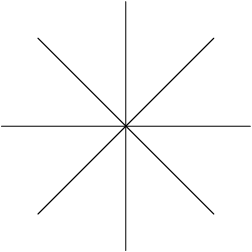

copeland
2015-02-04 20:26:59
Not surprising. . . we have 4 lines algebraically as well.
Not surprising. . . we have 4 lines algebraically as well.
copeland
2015-02-04 20:27:01
Now that we have that, let's switch gears. This is another probability problem. This looks like a successtotal type of computation. Let's nail down that 'total' part. How many values can aπ take?
Now that we have that, let's switch gears. This is another probability problem. This looks like a successtotal type of computation. Let's nail down that 'total' part. How many values can aπ take?
az_phx_brandon_jiang
2015-02-04 20:28:50
20
20
acsigaoyuan
2015-02-04 20:28:50
20
20
jigglypuff
2015-02-04 20:28:50
20
20
Yumantimatter
2015-02-04 20:28:50
20
20
hnkevin42
2015-02-04 20:28:50
20?
20?
copeland
2015-02-04 20:28:52
There are 20 possible values. I will arrange them by denominator.
There are 20 possible values. I will arrange them by denominator.
copeland
2015-02-04 20:28:57
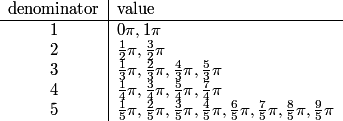

copeland
2015-02-04 20:29:00
Likewise, bπ can take these 20 values.
Likewise, bπ can take these 20 values.
copeland
2015-02-04 20:29:03
The rest of the problem is clever checking and clever bookkeeping. Here at the office we found the bookkeeping on this problem to be really frustrating so I will do things a little more carefully than you might be expecting.
The rest of the problem is clever checking and clever bookkeeping. Here at the office we found the bookkeeping on this problem to be really frustrating so I will do things a little more carefully than you might be expecting.
copeland
2015-02-04 20:29:13
First let's get the values of these trig functions into a table so we have something common that we can point at.
First let's get the values of these trig functions into a table so we have something common that we can point at.
copeland
2015-02-04 20:29:20


copeland
2015-02-04 20:29:32
You can double-click that to keep it around.
You can double-click that to keep it around.
masad24
2015-02-04 20:29:34
why is it so tiny?
why is it so tiny?
copeland
2015-02-04 20:29:38
Maybe this is better:
Maybe this is better:
copeland
2015-02-04 20:29:55
θ0π1π12π32π13π23π43π53π14π34π54π74π15π25π35π45π65π75π85π95πcos(θ)+1−100+12−12−12+12+1√2−1√2−1√2+1√2????????sin(θ)00+1−1+√32+√32−√32−√32+1√2+1√2−1√2−1√2????????
θ0π1π12π32π13π23π43π53π14π34π54π74π15π25π35π45π65π75π85π95πcos(θ)+1−100+12−12−12+12+1√2−1√2−1√2+1√2????????sin(θ)00+1−1+√32+√32−√32−√32+1√2+1√2−1√2−1√2????????
copeland
2015-02-04 20:30:23
OK, I may post images two times a couple more times later in this problem, too.
OK, I may post images two times a couple more times later in this problem, too.
copeland
2015-02-04 20:30:29
I don't know those fifths off-hand. I know that it's something-something-golden-ratio-something, but I really want to believe that we're not going to need to go that far.
I don't know those fifths off-hand. I know that it's something-something-golden-ratio-something, but I really want to believe that we're not going to need to go that far.
copeland
2015-02-04 20:30:39
Now let's look at our conditions. For how many pairs (aπ,bπ) is (A) cos(aπ)=0 satisfied?
Now let's look at our conditions. For how many pairs (aπ,bπ) is (A) cos(aπ)=0 satisfied?
trumpeter
2015-02-04 20:31:07
2
2
acsigaoyuan
2015-02-04 20:31:07
2
2
kingsave3166
2015-02-04 20:31:07
2
2
bobispro5
2015-02-04 20:31:07
2
2
ompatel99
2015-02-04 20:31:07
2
2
Duncanyang
2015-02-04 20:31:07
2
2
copeland
2015-02-04 20:31:12
It's on the table twice.
It's on the table twice.
copeland
2015-02-04 20:31:22
How many (a,b) pairs satisfy this equation, though?
How many (a,b) pairs satisfy this equation, though?
swirlykick
2015-02-04 20:31:48
2*20
2*20
zacchro
2015-02-04 20:31:48
40
40
kingsave3166
2015-02-04 20:31:48
oh actuall 2 * 20 = 40 right?
oh actuall 2 * 20 = 40 right?
hnkevin42
2015-02-04 20:31:48
40?
40?
bobispro5
2015-02-04 20:31:48
40
40
trumpeter
2015-02-04 20:31:48
actually 2*20=40
actually 2*20=40
Dukejukem
2015-02-04 20:31:48
2×20=40
2×20=40
lucylai
2015-02-04 20:31:48
40
40
zacchro
2015-02-04 20:31:48
40
40
tanuagg13
2015-02-04 20:31:48
40
40
ninjataco
2015-02-04 20:31:48
40
40
copeland
2015-02-04 20:31:54
This happens 20 times for each of aπ=π2 and aπ=3π2. That's 40 total.
This happens 20 times for each of aπ=π2 and aπ=3π2. That's 40 total.
copeland
2015-02-04 20:31:56
Here I'm going to make another table. I'm going to let the first column be the possible values of aπ and then I want to list all of the successful bπ that go with each aπ.
Here I'm going to make another table. I'm going to let the first column be the possible values of aπ and then I want to list all of the successful bπ that go with each aπ.
copeland
2015-02-04 20:31:59
You should get used to organizing things in tables for the AMC and AIME.
You should get used to organizing things in tables for the AMC and AIME.
copeland
2015-02-04 20:32:04


copeland
2015-02-04 20:32:11
Small again or alright?
Small again or alright?
copeland
2015-02-04 20:32:31
aπcos(aπ)=00π1π12πall 2032πall 2013π23π43π53π14π34π54π74π15π25π35π45π65π75π85π95π
aπcos(aπ)=00π1π12πall 2032πall 2013π23π43π53π14π34π54π74π15π25π35π45π65π75π85π95π
copeland
2015-02-04 20:32:45
How many times is sin(bπ)=0?
How many times is sin(bπ)=0?
lucylai
2015-02-04 20:33:27
40
40
cellobix
2015-02-04 20:33:27
40 times.
40 times.
trumpeter
2015-02-04 20:33:27
same as before, 40
same as before, 40
IceFireGold1
2015-02-04 20:33:27
40
40
copeland
2015-02-04 20:33:29
This happens when bπ=0 and bπ=π. That's another 20+20. So we're at 80 now?
This happens when bπ=0 and bπ=π. That's another 20+20. So we're at 80 now?
Dukejukem
2015-02-04 20:34:17
2×20=40, but now we're overcounting some cases when sin(bπ)=0 and cos(aπ)=0
2×20=40, but now we're overcounting some cases when sin(bπ)=0 and cos(aπ)=0
kingsave3166
2015-02-04 20:34:17
40 times, but intersected 4 times so add 36
40 times, but intersected 4 times so add 36
acsigaoyuan
2015-02-04 20:34:17
76
76
zacchro
2015-02-04 20:34:17
76
76
treemath
2015-02-04 20:34:17
overcounted
overcounted
acsigaoyuan
2015-02-04 20:34:17
4 cases are repeated, so 76
4 cases are repeated, so 76
lucylai
2015-02-04 20:34:17
subtract 4 for overcounting
subtract 4 for overcounting
pedronr
2015-02-04 20:34:17
no, double counted api=bpi=0
no, double counted api=bpi=0
bobispro5
2015-02-04 20:34:17
4 repeats to be exact
4 repeats to be exact
Dukejukem
2015-02-04 20:34:17
We've overcounted four cases when sin(bπ)=cos(aπ)=0.
We've overcounted four cases when sin(bπ)=cos(aπ)=0.
copeland
2015-02-04 20:34:20
No. 4 of those intersect. We are 76 now. (I'll put the 4 repeats in red.)
No. 4 of those intersect. We are 76 now. (I'll put the 4 repeats in red.)
copeland
2015-02-04 20:34:23
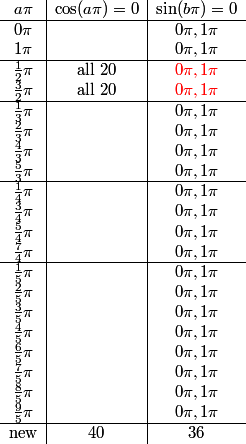

copeland
2015-02-04 20:34:33
Now we need to consider when cos(aπ)=±sin(bπ). Let's do this by denominator.
Now we need to consider when cos(aπ)=±sin(bπ). Let's do this by denominator.
copeland
2015-02-04 20:34:35
Here is our table of values again:
Here is our table of values again:
copeland
2015-02-04 20:34:39
θ0π1π12π32π13π23π43π53π14π34π54π74π15π25π35π45π65π75π85π95πcos(θ)+1−100+12−12−12+12+1√2−1√2−1√2+1√2????????sin(θ)00+1−1+√32+√32−√32−√32+1√2+1√2−1√2−1√2????????
θ0π1π12π32π13π23π43π53π14π34π54π74π15π25π35π45π65π75π85π95πcos(θ)+1−100+12−12−12+12+1√2−1√2−1√2+1√2????????sin(θ)00+1−1+√32+√32−√32−√32+1√2+1√2−1√2−1√2????????
copeland
2015-02-04 20:34:48
When the denominator of a is 1 when do we get cos(aπ)=sin(bπ)?
When the denominator of a is 1 when do we get cos(aπ)=sin(bπ)?
kingsave3166
2015-02-04 20:35:55
4
4
gxah
2015-02-04 20:35:55
pi/4, 5pi/4
pi/4, 5pi/4
acsigaoyuan
2015-02-04 20:35:55
a=0, b= 1/2 or a=1,b= 3/2
a=0, b= 1/2 or a=1,b= 3/2
mihirb
2015-02-04 20:35:55
Twice?
Twice?
bobispro5
2015-02-04 20:35:55
4 cases
4 cases
copeland
2015-02-04 20:36:00
This is good, let's expand that.
This is good, let's expand that.
copeland
2015-02-04 20:37:22
When the denominator of a is 1 we have cos=±1.
When the denominator of a is 1 we have cos=±1.
copeland
2015-02-04 20:37:26
When is sin=±1?
When is sin=±1?
gxah
2015-02-04 20:37:59
0 or pi
0 or pi
bobispro5
2015-02-04 20:37:59
it is multiple of pi
it is multiple of pi
fredgauss
2015-02-04 20:37:59
at \pi or at 0.
at \pi or at 0.
happyhummingbird
2015-02-04 20:37:59
0pi pi
0pi pi
acsigaoyuan
2015-02-04 20:37:59
b=1/2, 3/2
b=1/2, 3/2
bli1999
2015-02-04 20:37:59
b=1/2 or 3/2
b=1/2 or 3/2
EulerMacaroni
2015-02-04 20:37:59
pi/2, 3pi/2
pi/2, 3pi/2
copeland
2015-02-04 20:38:02
We get that exactly when the denominator of b is 2.
We get that exactly when the denominator of b is 2.
copeland
2015-02-04 20:38:04
When the denominator of a is 2 when do we get cos(aπ)=sin(bπ)?
When the denominator of a is 2 when do we get cos(aπ)=sin(bπ)?
EulerMacaroni
2015-02-04 20:38:59
when b is an integer
when b is an integer
bobispro5
2015-02-04 20:38:59
denominator of b is 1
denominator of b is 1
acsigaoyuan
2015-02-04 20:38:59
b=0 or 1
b=0 or 1
Happytycho
2015-02-04 20:38:59
b=1 or b=0
b=1 or b=0
copeland
2015-02-04 20:39:01
. . .and. . .
. . .and. . .
lucylai
2015-02-04 20:39:04
we've already counted these cases
we've already counted these cases
copeland
2015-02-04 20:39:07
We get that exactly when the denominator of b is 1.
We get that exactly when the denominator of b is 1.
copeland
2015-02-04 20:39:09
OK, let's put those on our chart. I'm putting the 4 we already counted in red again.
OK, let's put those on our chart. I'm putting the 4 we already counted in red again.
copeland
2015-02-04 20:39:13
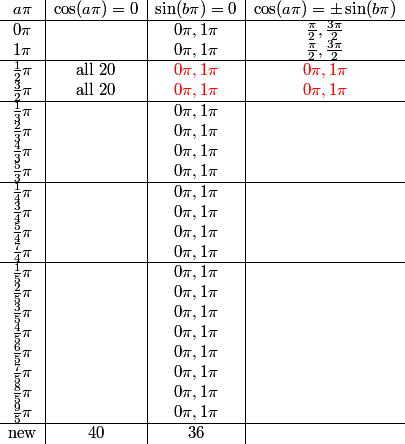

copeland
2015-02-04 20:39:45
What about when the denominator is 3?
What about when the denominator is 3?
copeland
2015-02-04 20:39:51
When the denominator is 3 we have |cos(aπ)|=12 but we always have |sin(bπ)|=√32. That's weird. What happened?
When the denominator is 3 we have |cos(aπ)|=12 but we always have |sin(bπ)|=√32. That's weird. What happened?
flyrain
2015-02-04 20:40:25
it's just the nature of 3
it's just the nature of 3
copeland
2015-02-04 20:40:26
3. You're so crazy!
3. You're so crazy!
acsigaoyuan
2015-02-04 20:40:53
none of them work
none of them work
bobispro5
2015-02-04 20:40:53
we need the denominator to be 6
we need the denominator to be 6
DrMath
2015-02-04 20:40:53
bad 3, everything should be <3
bad 3, everything should be <3
bobispro5
2015-02-04 20:40:53
we need denominator to be 6 in order to have sin(x) = 1/2
we need denominator to be 6 in order to have sin(x) = 1/2
copeland
2015-02-04 20:40:57
We're trying to solve cos(aπ)=±sin(bπ). Cosine and sine are hard to compare so it's better to write cos(aπ)=±cos(π2−bπ)
We're trying to solve cos(aπ)=±sin(bπ). Cosine and sine are hard to compare so it's better to write cos(aπ)=±cos(π2−bπ)
copeland
2015-02-04 20:41:04
That happens when we can solve some equation with aπ, bπ, and π2. However if the denominator of a is odd, we will need the denominator of b to be twice that in order to solve the equation. By way of example:
cos(1π3)=sin(π6)=sin(5π6)=−sin(7π6)=−sin(11π6)cos(3π5)=−sin(π10)=−sin(9π10)=sin(11π10)=sin(19π10)
That happens when we can solve some equation with aπ, bπ, and π2. However if the denominator of a is odd, we will need the denominator of b to be twice that in order to solve the equation. By way of example:
cos(1π3)=sin(π6)=sin(5π6)=−sin(7π6)=−sin(11π6)cos(3π5)=−sin(π10)=−sin(9π10)=sin(11π10)=sin(19π10)
copeland
2015-02-04 20:41:25
So. . .
So. . .
bli1999
2015-02-04 20:42:11
The sin can't be equal to the cosine
The sin can't be equal to the cosine
acsigaoyuan
2015-02-04 20:42:11
We can only try the cases where denominator is 4
We can only try the cases where denominator is 4
copeland
2015-02-04 20:42:15
When the denominator of a is an odd value d we would need the denominator of b to be 2d. Therefore we never enter case (C) when d is 3 or 5.
When the denominator of a is an odd value d we would need the denominator of b to be 2d. Therefore we never enter case (C) when d is 3 or 5.
acsigaoyuan
2015-02-04 20:42:29
denominator = 4 gives the last 16 cases
denominator = 4 gives the last 16 cases
copeland
2015-02-04 20:42:37
All that is left is denominator 4. If aπ is an odd multiple of π4 when are we in case (C), cos(aπ)=±sin(bπ)?
All that is left is denominator 4. If aπ is an odd multiple of π4 when are we in case (C), cos(aπ)=±sin(bπ)?
bobispro5
2015-02-04 20:42:58
16 cases
16 cases
copeland
2015-02-04 20:43:02
How many of them work?
How many of them work?
copeland
2015-02-04 20:44:41
That is, how many of our cosuπ4=±sinvπ4 are true?
That is, how many of our cosuπ4=±sinvπ4 are true?
Studiosa
2015-02-04 20:44:53
all of them?
all of them?
bobispro5
2015-02-04 20:44:53
all?
all?
acsigaoyuan
2015-02-04 20:44:53
16, any combination works
16, any combination works
cellobix
2015-02-04 20:44:53
All of them work.
All of them work.
Happytycho
2015-02-04 20:44:53
all 16?
all 16?
Dukejukem
2015-02-04 20:44:53
4×4=16 times
4×4=16 times
copeland
2015-02-04 20:44:59
In this instance everything is either ±1√2. Now we pick up all of the pairs (aπ,bπ) where either one is an odd multiple of π4.
In this instance everything is either ±1√2. Now we pick up all of the pairs (aπ,bπ) where either one is an odd multiple of π4.
copeland
2015-02-04 20:45:02
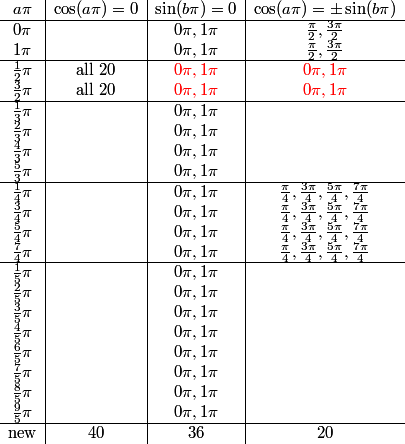

copeland
2015-02-04 20:45:08
aπcos(aπ)=0sin(bπ)=0cos(aπ)=±sin(bπ)0π0π,1ππ2,3π21π0π,1ππ2,3π212πall 200π,1π0π,1π32πall 200π,1π0π,1π13π0π,1π23π0π,1π43π0π,1π53π0π,1π14π0π,1ππ4,3π4,5π4,7π434π0π,1ππ4,3π4,5π4,7π454π0π,1ππ4,3π4,5π4,7π474π0π,1ππ4,3π4,5π4,7π415π0π,1π25π0π,1π35π0π,1π45π0π,1π65π0π,1π75π0π,1π85π0π,1π95π0π,1πnew403620
aπcos(aπ)=0sin(bπ)=0cos(aπ)=±sin(bπ)0π0π,1ππ2,3π21π0π,1ππ2,3π212πall 200π,1π0π,1π32πall 200π,1π0π,1π13π0π,1π23π0π,1π43π0π,1π53π0π,1π14π0π,1ππ4,3π4,5π4,7π434π0π,1ππ4,3π4,5π4,7π454π0π,1ππ4,3π4,5π4,7π474π0π,1ππ4,3π4,5π4,7π415π0π,1π25π0π,1π35π0π,1π45π0π,1π65π0π,1π75π0π,1π85π0π,1π95π0π,1πnew403620
copeland
2015-02-04 20:45:11
And the answer?
And the answer?
Studiosa
2015-02-04 20:46:09
D
D
bobispro5
2015-02-04 20:46:09
96/400
96/400
acsigaoyuan
2015-02-04 20:46:09
D, 96/400 = 6/25
D, 96/400 = 6/25
giftedbee
2015-02-04 20:46:09
96/400=6/25=D
96/400=6/25=D
bobispro5
2015-02-04 20:46:09
96/400 --> 6/25 (D)
96/400 --> 6/25 (D)
briyellowduck
2015-02-04 20:46:09
D
D
mathwizard888
2015-02-04 20:46:09
D
D
MathStudent2002
2015-02-04 20:46:09
96/400=6/25 (D)
96/400=6/25 (D)
EulerMacaroni
2015-02-04 20:46:09
6/25
6/25
wehac
2015-02-04 20:46:09
96/400=6/25
96/400=6/25
briyellowduck
2015-02-04 20:46:09
6/25
6/25
spartan168
2015-02-04 20:46:09
D!
D!
ompatel99
2015-02-04 20:46:51
How are we expected to solve this on test day with a time limit?
How are we expected to solve this on test day with a time limit?
copeland
2015-02-04 20:46:53
No idea. This problem was a lot of work. The redeeming feature for me was that the distractors were all so bad that I knew when I made a mistake - the answer wasn't there!
No idea. This problem was a lot of work. The redeeming feature for me was that the distractors were all so bad that I knew when I made a mistake - the answer wasn't there!
copeland
2015-02-04 20:47:21
Sorry, by "bad" I mean there are so many ways to fail at this problem that making it multiple choice makes it much easier.
Sorry, by "bad" I mean there are so many ways to fail at this problem that making it multiple choice makes it much easier.
briyellowduck
2015-02-04 20:47:52
Now the biggest and baddest...
Now the biggest and baddest...
copeland
2015-02-04 20:47:53
Oh hey! We've got one more problem to go!
Oh hey! We've got one more problem to go!
copeland
2015-02-04 20:48:09
Interestingly, I thought 24 was both biggest and baddest.
Interestingly, I thought 24 was both biggest and baddest.
copeland
2015-02-04 20:48:15
25. A collection of circles in the upper half-plane, all tangent to the x-axis, is constructed in layers as follows. Layer L0 consists of two circles of radii 702 and 732 that are externally tangent. For k≥1, the circles in ⋃k−1j=0Lj are ordered according to their points of tangency with the x-axis. For every pair of consecutive circles in this order, a new circle is constructed externally tangent to each of the two circles in the pair. Layer Lk consists of the 2k−1 circles constructed in this way. Let S=⋃6j=0Lj, and for every circle C denote by r(C) its radius. What is
∑C∈S1√r(C)?
golly
(A) 28635 (B) 58370 (C) 71573 (D) 14314 (E) 1573146
25. A collection of circles in the upper half-plane, all tangent to the x-axis, is constructed in layers as follows. Layer L0 consists of two circles of radii 702 and 732 that are externally tangent. For k≥1, the circles in ⋃k−1j=0Lj are ordered according to their points of tangency with the x-axis. For every pair of consecutive circles in this order, a new circle is constructed externally tangent to each of the two circles in the pair. Layer Lk consists of the 2k−1 circles constructed in this way. Let S=⋃6j=0Lj, and for every circle C denote by r(C) its radius. What is
∑C∈S1√r(C)?
golly
(A) 28635 (B) 58370 (C) 71573 (D) 14314 (E) 1573146
cellobix
2015-02-04 20:48:36
...What?
...What?
copeland
2015-02-04 20:48:41
Yes. Words.
Yes. Words.
copeland
2015-02-04 20:48:48
Oh, I owe you a picture.
Oh, I owe you a picture.
copeland
2015-02-04 20:48:50
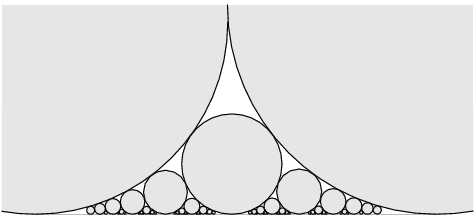

copeland
2015-02-04 20:48:55
Looks complicated! Where can we start?
Looks complicated! Where can we start?
Dukejukem
2015-02-04 20:50:59
Descartes Circle Theorem?
Descartes Circle Theorem?
mssmath
2015-02-04 20:50:59
Either Decartes or use Pythag
Either Decartes or use Pythag
copeland
2015-02-04 20:51:02
This is an unfortunate thing about this problem. There's a theorem that gives us a shortcut.
This is an unfortunate thing about this problem. There's a theorem that gives us a shortcut.
copeland
2015-02-04 20:51:22
Let's figure out how to construct the new circles.
Let's figure out how to construct the new circles.
copeland
2015-02-04 20:51:24
Specifically, if we want to place a new circle between a circle of radius r and a circle of radius s, how big should the new circle be?
Specifically, if we want to place a new circle between a circle of radius r and a circle of radius s, how big should the new circle be?
copeland
2015-02-04 20:51:37
Here's a picture:
Here's a picture:
copeland
2015-02-04 20:51:39
How can we determine t in terms of r and s?
How can we determine t in terms of r and s?
copeland
2015-02-04 20:51:42
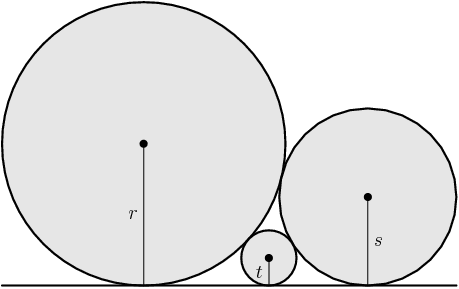

Tuxianeer
2015-02-04 20:52:32
draw some center to center lines
draw some center to center lines
hnkevin42
2015-02-04 20:52:32
pythagorean theorem?
pythagorean theorem?
Studiosa
2015-02-04 20:52:32
Draw triangles
Draw triangles
ompatel99
2015-02-04 20:52:32
connect centers and pythag
connect centers and pythag
Duncanyang
2015-02-04 20:52:32
pythagorean theorem
pythagorean theorem
DivideBy0
2015-02-04 20:52:32
connect centers through tangent points
connect centers through tangent points
happyhummingbird
2015-02-04 20:52:32
pythagorean theoreom by connecting the radi
pythagorean theoreom by connecting the radi
DivideBy0
2015-02-04 20:52:32
connect centers through tangent points and make pythag equations
connect centers through tangent points and make pythag equations
EulerMacaroni
2015-02-04 20:52:37
Connect centers and apply the Pythagorean theorem
Connect centers and apply the Pythagorean theorem
acsigaoyuan
2015-02-04 20:52:38
All I did is using simple pythagorean...
All I did is using simple pythagorean...
copeland
2015-02-04 20:52:40
Usually it's really helpful to connect the centers, so let's do that:
Usually it's really helpful to connect the centers, so let's do that:
copeland
2015-02-04 20:52:44
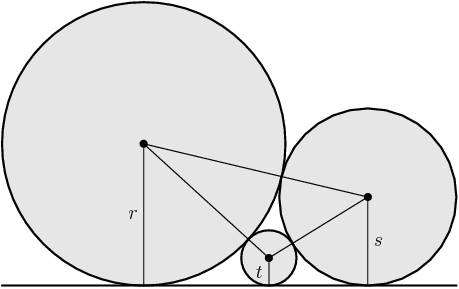

copeland
2015-02-04 20:52:44
It's also usually really helpful to create right triangles...
It's also usually really helpful to create right triangles...
copeland
2015-02-04 20:52:45
So let's draw some horizontal lines to make right triangles:
So let's draw some horizontal lines to make right triangles:
copeland
2015-02-04 20:52:49
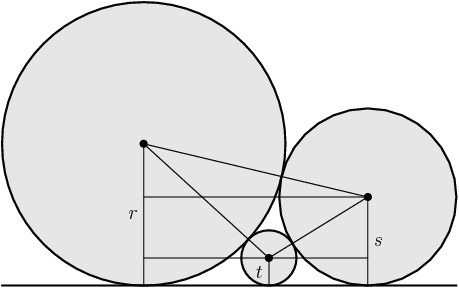

copeland
2015-02-04 20:52:53
What do we know about the blue triangle below?
What do we know about the blue triangle below?
copeland
2015-02-04 20:52:56


EulerMacaroni
2015-02-04 20:53:26
there is a right angle
there is a right angle
prpaxson
2015-02-04 20:53:26
it is a right triangle
it is a right triangle
masad24
2015-02-04 20:53:26
its a right triangle
its a right triangle
flyrain
2015-02-04 20:53:26
we know it's side lenghts
we know it's side lenghts
copeland
2015-02-04 20:53:27
And its dimensions?
And its dimensions?
bobispro5
2015-02-04 20:53:58
hypotenuse r+s, one leg r-s
hypotenuse r+s, one leg r-s
mathmass
2015-02-04 20:53:58
r-s,r+s
r-s,r+s
jkyman
2015-02-04 20:53:58
hypotenuse is r + s
hypotenuse is r + s
mathmass
2015-02-04 20:53:58
r-s
r-s
EulerMacaroni
2015-02-04 20:53:58
r-s, r+s
r-s, r+s
acsigaoyuan
2015-02-04 20:53:58
r+s, r-s and d where d is the length of the bottom line
r+s, r-s and d where d is the length of the bottom line
pinkrock
2015-02-04 20:53:58
r+s is hypoteneuse
r+s is hypoteneuse
treemath
2015-02-04 20:53:58
hypotenuse = r+s and short leg = r-s
hypotenuse = r+s and short leg = r-s
Studiosa
2015-02-04 20:53:58
hypotenuse r+s, leg r-s
hypotenuse r+s, leg r-s
copeland
2015-02-04 20:54:02
Its hypotenuse is r+s and its left leg is r−s. So what is the horizontal leg?
Its hypotenuse is r+s and its left leg is r−s. So what is the horizontal leg?
bobispro5
2015-02-04 20:54:33
r+s, r-s, 2*sqrt(rs)
r+s, r-s, 2*sqrt(rs)
flyrain
2015-02-04 20:54:33
r-s, r+s, sqrt(4rs)
r-s, r+s, sqrt(4rs)
drywood
2015-02-04 20:54:33
r-s by r+s by 2sqrtrs
r-s by r+s by 2sqrtrs
lucylai
2015-02-04 20:54:33
r+s,r-s,2sqrt(rs)
r+s,r-s,2sqrt(rs)
MathStudent2002
2015-02-04 20:54:33
2sqrt(rs)
2sqrt(rs)
drywood
2015-02-04 20:54:33
2sqrt(rs)
2sqrt(rs)
mrowhed
2015-02-04 20:54:33
2 sqrt(rs)
2 sqrt(rs)
math_cool
2015-02-04 20:54:33
2(sqrt(rs))
2(sqrt(rs))
MathStudent2002
2015-02-04 20:54:33
2√rs
2√rs
wehac
2015-02-04 20:54:33
2sqrt(rs)
2sqrt(rs)
copeland
2015-02-04 20:54:35
It's √(r+s)2−(r−s)2.
It's √(r+s)2−(r−s)2.
copeland
2015-02-04 20:54:37
This simplifies to just 2√rs.
This simplifies to just 2√rs.
copeland
2015-02-04 20:54:39
Now, what about the two red triangles below?
Now, what about the two red triangles below?
copeland
2015-02-04 20:54:43


masad24
2015-02-04 20:55:14
they are right triangles too
they are right triangles too
Duncanyang
2015-02-04 20:55:14
they are right
they are right
prpaxson
2015-02-04 20:55:14
also right triangles
also right triangles
Happytycho
2015-02-04 20:55:17
also right triangles
also right triangles
copeland
2015-02-04 20:55:19
What else are they, now that we're talking similarities?
What else are they, now that we're talking similarities?
copeland
2015-02-04 20:56:16
(They are not 'similar.' That was not a hint at something.)
(They are not 'similar.' That was not a hint at something.)
drywood
2015-02-04 20:56:46
they have horizontal sides of length 2sqrt(rt) and 2sqrt(st)
they have horizontal sides of length 2sqrt(rt) and 2sqrt(st)
Studiosa
2015-02-04 20:56:46
same process for hypotenuse and short leg
same process for hypotenuse and short leg
Studiosa
2015-02-04 20:56:46
r+t and s+t for the hypotenuses, r-t and s-t for legs
r+t and s+t for the hypotenuses, r-t and s-t for legs
az_phx_brandon_jiang
2015-02-04 20:56:46
also r-t and r+t, s-t and s+t
also r-t and r+t, s-t and s+t
Dukejukem
2015-02-04 20:56:57
"Double-counting," we find that 2√rs=√(s+t)2−(s−t)2+√(r+t)2−(r−t)2=2√st+2√rt
"Double-counting," we find that 2√rs=√(s+t)2−(s−t)2+√(r+t)2−(r−t)2=2√st+2√rt
acsigaoyuan
2015-02-04 20:56:59
On left: hypotenuse r+t, left leg r-t, horizontal leg 2*sqrt(rt)
On left: hypotenuse r+t, left leg r-t, horizontal leg 2*sqrt(rt)
copeland
2015-02-04 20:57:02
By the same reasoning, the horizontal leg of the left triangle is 2√rt, and the horizontal leg of the right triangle is 2√st.
By the same reasoning, the horizontal leg of the left triangle is 2√rt, and the horizontal leg of the right triangle is 2√st.
copeland
2015-02-04 20:57:13
Since the blue horizontal leg must equal the sum of the two red ones, we have
2√rs=2√rt+2√st.
Since the blue horizontal leg must equal the sum of the two red ones, we have
2√rs=2√rt+2√st.
copeland
2015-02-04 20:57:30
We could solve this for t, but what's a better idea?
We could solve this for t, but what's a better idea?
lucylai
2015-02-04 20:58:21
divide by 2sqrt(rst)
divide by 2sqrt(rst)
mrowhed
2015-02-04 20:58:21
divide by 2 sqrt(rst)
divide by 2 sqrt(rst)
awesomemathlete
2015-02-04 20:58:21
divide by 2√rst
divide by 2√rst
TheMaskedMagician
2015-02-04 20:58:21


ashgabat
2015-02-04 20:58:21
Divide everything by sqrt(r*s*t)/2
Divide everything by sqrt(r*s*t)/2
copeland
2015-02-04 20:58:25
Let's make it a bit nicer by dividing through by 2√rst. This gives us
1√t=1√s+1√r.
Let's make it a bit nicer by dividing through by 2√rst. This gives us
1√t=1√s+1√r.
copeland
2015-02-04 20:58:39
Are we on the right track?
Are we on the right track?
ashgabat
2015-02-04 20:59:02
It's of the form we want in the answer
It's of the form we want in the answer
Dukejukem
2015-02-04 20:59:02
Aha! this looks like the obscure sum we're supposed to calculate
Aha! this looks like the obscure sum we're supposed to calculate
kingsave3166
2015-02-04 20:59:02
yeah we have reciprocals in the question
yeah we have reciprocals in the question
MathStudent2002
2015-02-04 20:59:02
Hey look 1√t is part of our answer!
Hey look 1√t is part of our answer!
TheMaskedMagician
2015-02-04 20:59:02
Says we see reciprocals of radicals in the desired sum
Says we see reciprocals of radicals in the desired sum
copeland
2015-02-04 20:59:06
Aha! These are the same terms that we have in the sum that we want to compute: reciprocals of square roots of radii!
Aha! These are the same terms that we have in the sum that we want to compute: reciprocals of square roots of radii!
copeland
2015-02-04 20:59:10
Now what?
Now what?
acsigaoyuan
2015-02-04 20:59:54
find L1, L2, ...
find L1, L2, ...
codyj
2015-02-04 20:59:54
small cases
small cases
prpaxson
2015-02-04 20:59:54
plug in the ones given, 70^2 and 73^2
plug in the ones given, 70^2 and 73^2
Tuxianeer
2015-02-04 20:59:54
start with 70^2 and 73^2
start with 70^2 and 73^2
TheMaskedMagician
2015-02-04 20:59:54
Find the sum for each layer in terms of L0
Find the sum for each layer in terms of L0
ompatel99
2015-02-04 20:59:54
use layer L0
use layer L0
pinkrock
2015-02-04 20:59:54
create series
create series
copeland
2015-02-04 20:59:56
Now we have to keep track of the sums of these things, so let's name them.
Now we have to keep track of the sums of these things, so let's name them.
copeland
2015-02-04 21:00:03
Let's set Rk to be the sum of these terms for the circles in level k, and let's set Sk to be the sum of these terms for all the levels 0 up through k. So what we want to compute is S6=R0+R1+R2+⋯+R6.
Let's set Rk to be the sum of these terms for the circles in level k, and let's set Sk to be the sum of these terms for all the levels 0 up through k. So what we want to compute is S6=R0+R1+R2+⋯+R6.
copeland
2015-02-04 21:00:14
Also, so we don't have to carry all the numbers around, let's set a=170 and b=173. Then R0=S0=a+b.
Also, so we don't have to carry all the numbers around, let's set a=170 and b=173. Then R0=S0=a+b.
copeland
2015-02-04 21:00:23
How do we compute Rk?
How do we compute Rk?
acsigyz
2015-02-04 21:00:42
very carefully
very carefully
giftedbee
2015-02-04 21:00:42
Recursively!
Recursively!
copeland
2015-02-04 21:00:44
Alright!
Alright!
copeland
2015-02-04 21:00:53
So, recursion. . .
So, recursion. . .
pinkrock
2015-02-04 21:01:27
use the previous levels and the formula we found
use the previous levels and the formula we found
copeland
2015-02-04 21:01:29
How can we use those?
How can we use those?
copeland
2015-02-04 21:02:21
What does our formula tell us about the sum of the reciprocals of all the circles in Lk?
What does our formula tell us about the sum of the reciprocals of all the circles in Lk?
Dukejukem
2015-02-04 21:02:58
Note that every circle O in the kth layer is constructed from two circles in the k−1th layer. Hence, Rk=2Rk−1
Note that every circle O in the kth layer is constructed from two circles in the k−1th layer. Hence, Rk=2Rk−1
copeland
2015-02-04 21:03:01
This is close.
This is close.
copeland
2015-02-04 21:03:16
Every circle is 'made from' circles in the previous layers.
Every circle is 'made from' circles in the previous layers.
copeland
2015-02-04 21:04:16
Except Rk counts just the current layer. What do we really count from before when constructing?
Except Rk counts just the current layer. What do we really count from before when constructing?
copeland
2015-02-04 21:04:31
Here's our picture again:
Here's our picture again:
copeland
2015-02-04 21:04:32


copeland
2015-02-04 21:04:52
Layer 1 has 1 circle. Layer 2 has 2 and Layer 4 has 4.
Layer 1 has 1 circle. Layer 2 has 2 and Layer 4 has 4.
copeland
2015-02-04 21:05:10
How many circles do I need to use to construct Layer 4?
How many circles do I need to use to construct Layer 4?
copeland
2015-02-04 21:05:15
(Layer 0 also has 2.)
(Layer 0 also has 2.)
acsigaoyuan
2015-02-04 21:06:02
We count all existing circles?
We count all existing circles?
kingsave3166
2015-02-04 21:06:02
layer 4 needs 8
layer 4 needs 8
briyellowduck
2015-02-04 21:06:02
8
8
copeland
2015-02-04 21:06:03
5 and 8 are both good answers. I need ALL 5 of the previous circles. I count some of them twice so with multiplicity I need 8.
5 and 8 are both good answers. I need ALL 5 of the previous circles. I count some of them twice so with multiplicity I need 8.
copeland
2015-02-04 21:06:09
Which ones do I count once?
Which ones do I count once?
Tuxianeer
2015-02-04 21:06:59
70^2 and 73^2
70^2 and 73^2
az_phx_brandon_jiang
2015-02-04 21:06:59
The outer original two
The outer original two
acsigaoyuan
2015-02-04 21:06:59
the two on L0
the two on L0
kingsave3166
2015-02-04 21:06:59
70 and 73
70 and 73
Studiosa
2015-02-04 21:06:59
The ones on the outside ends
The ones on the outside ends
copeland
2015-02-04 21:07:03
I count the ends once. Just for creating the first and last circles.
I count the ends once. Just for creating the first and last circles.
copeland
2015-02-04 21:07:08
And which ones do I count twice?
And which ones do I count twice?
lucylai
2015-02-04 21:07:36
everything else
everything else
acsigaoyuan
2015-02-04 21:07:36
all the rest
all the rest
Studiosa
2015-02-04 21:07:36
The smaller ones on the inside
The smaller ones on the inside
math_cool
2015-02-04 21:07:36
Everything other circle
Everything other circle
eswa2000
2015-02-04 21:07:36
the middle ones
the middle ones
DivideBy0
2015-02-04 21:07:36
all the ones in the middle
all the ones in the middle
kingsave3166
2015-02-04 21:07:36
the ones we made in the prev layer
the ones we made in the prev layer
owm
2015-02-04 21:07:36
all of the others
all of the others
copeland
2015-02-04 21:07:39
All the rest!
All the rest!
copeland
2015-02-04 21:07:52
Using our formula, it's the sum of these "reciprocal of square root" terms for all the circles that we already have in the lower levels.
Using our formula, it's the sum of these "reciprocal of square root" terms for all the circles that we already have in the lower levels.
copeland
2015-02-04 21:07:53
And each circle we already have is counted twice...
And each circle we already have is counted twice...
copeland
2015-02-04 21:07:55
...except for the two big circles on the ends, which only get counted once.
...except for the two big circles on the ends, which only get counted once.
copeland
2015-02-04 21:08:24
The sum of the reciprocals for all the layers up to k is Sk.
The sum of the reciprocals for all the layers up to k is Sk.
copeland
2015-02-04 21:08:35
The sum of the reciprocals on just layer k is Rk.
The sum of the reciprocals on just layer k is Rk.
copeland
2015-02-04 21:08:47
What recursive formula should we get for Rk?
What recursive formula should we get for Rk?
Dukejukem
2015-02-04 21:10:04
Ok, so Rk=R0+2(R1+R2+...+Rk−1)?
Ok, so Rk=R0+2(R1+R2+...+Rk−1)?
lucylai
2015-02-04 21:10:04
R_k=2S_k-R_0
R_k=2S_k-R_0
acsigaoyuan
2015-02-04 21:10:04
R_k=2S_k-a-b
R_k=2S_k-a-b
Dukejukem
2015-02-04 21:10:04
Ok, so Rk=R0+2(R1+R2+...+Rk−1)=2Sk−1−R0?
Ok, so Rk=R0+2(R1+R2+...+Rk−1)=2Sk−1−R0?
pinkrock
2015-02-04 21:10:04
Rk = 2Sk-(1/rt70 + 1/rt73)
Rk = 2Sk-(1/rt70 + 1/rt73)
copeland
2015-02-04 21:10:07
Great.
Great.
copeland
2015-02-04 21:10:13
We have Rk=2Sk−1−a−b.
We have Rk=2Sk−1−a−b.
copeland
2015-02-04 21:10:18
And what does that give us for Sk?
And what does that give us for Sk?
lucylai
2015-02-04 21:11:32
S_k=3S_(k-1)-R_0
S_k=3S_(k-1)-R_0
giftedbee
2015-02-04 21:11:32
3S_K-1 -a-b
3S_K-1 -a-b
kingsave3166
2015-02-04 21:11:32
S_k = 3s_(k-1)-a-b?
S_k = 3s_(k-1)-a-b?
acsigaoyuan
2015-02-04 21:11:32
S_k = 3*S_k-1 - a - b
S_k = 3*S_k-1 - a - b
copeland
2015-02-04 21:11:35
Sk=Rk+Sk−1=3Sk−1−a−b.
Sk=Rk+Sk−1=3Sk−1−a−b.
copeland
2015-02-04 21:12:02
Since a+b=R0 we now have the simple recurrence S0=R0 and Sk=3Sk−1−R0.
Since a+b=R0 we now have the simple recurrence S0=R0 and Sk=3Sk−1−R0.
copeland
2015-02-04 21:12:09
What does that ALMOST look like?
What does that ALMOST look like?
cellobix
2015-02-04 21:13:21
Geometric sequence
Geometric sequence
lucylai
2015-02-04 21:13:21
S_k=3^k*R_0
S_k=3^k*R_0
va2010
2015-02-04 21:13:21
powers of 3!
powers of 3!
zacchro
2015-02-04 21:13:21
powers of three recurrence?
powers of three recurrence?
copeland
2015-02-04 21:13:23
That is almost geometric. Can we do something to make it geometric?
That is almost geometric. Can we do something to make it geometric?
copeland
2015-02-04 21:14:23
Can you see a way to make the right side a third of the left side?
Can you see a way to make the right side a third of the left side?
cellobix
2015-02-04 21:15:32
Subtract (R_0)/2 from both sides
Subtract (R_0)/2 from both sides
giftedbee
2015-02-04 21:15:32
Do a new Sk=Sk-(a-b)/2
Do a new Sk=Sk-(a-b)/2
lucylai
2015-02-04 21:15:32
subtract R_0/2 from both sides
subtract R_0/2 from both sides
kingsave3166
2015-02-04 21:15:32
subtract r_0 / 2 from both sides
subtract r_0 / 2 from both sides
copeland
2015-02-04 21:15:40
It's almost exponential. We can make it exponential by subtracting R02:Sk−R02=3(Sk−1−R02).
It's almost exponential. We can make it exponential by subtracting R02:Sk−R02=3(Sk−1−R02).
copeland
2015-02-04 21:15:50
(Cool, huh?)
(Cool, huh?)
copeland
2015-02-04 21:15:53
Going down the chain we get Sk−R02=3k(S0−R02)=3kR02.orSk=(3k+1)R02.
Going down the chain we get Sk−R02=3k(S0−R02)=3kR02.orSk=(3k+1)R02.
copeland
2015-02-04 21:16:10
So our answer is (729+1)2(170+173).
So our answer is (729+1)2(170+173).
copeland
2015-02-04 21:16:42
Want me to do the arithmetic?
Want me to do the arithmetic?
giftedbee
2015-02-04 21:16:55
365*143/70*73=143/14=D
365*143/70*73=143/14=D
mrowhed
2015-02-04 21:16:55
yea
yea
prpaxson
2015-02-04 21:16:55
yes
yes
treemath
2015-02-04 21:16:55
sure
sure
kingsave3166
2015-02-04 21:16:55
yes please
yes please
acsigaoyuan
2015-02-04 21:16:55
143/14!
143/14!
Jayjayliu
2015-02-04 21:16:55
do it
do it
bobispro5
2015-02-04 21:16:55
lol its nice
lol its nice
treemath
2015-02-04 21:16:55
please doooooooooooo
please doooooooooooo
pinkrock
2015-02-04 21:16:55
yes please
yes please
copeland
2015-02-04 21:16:58
This simplifies to 7314+5=14314. Answer (D).
This simplifies to 7314+5=14314. Answer (D).
copeland
2015-02-04 21:17:18
If you don't see that exponential thing right away you could just grind through the recursion directly.
If you don't see that exponential thing right away you could just grind through the recursion directly.
copeland
2015-02-04 21:17:40
If you write c=R0, the recursion looks something like:
If you write c=R0, the recursion looks something like:
copeland
2015-02-04 21:17:44
S0=cS1=3S0−c=2cS2=3S1−c=5cS3=3S2−c=14cS4=3S3−c=41cS5=3S4−c=122cS6=3S5−c=365c
S0=cS1=3S0−c=2cS2=3S1−c=5cS3=3S2−c=14cS4=3S3−c=41cS5=3S4−c=122cS6=3S5−c=365c
copeland
2015-02-04 21:17:56
So our answer is again 365c=365(170+173).
So our answer is again 365c=365(170+173).
Tuxianeer
2015-02-04 21:18:35
unfortunately 143=70+73 so it seems more easily guessable than would be best
unfortunately 143=70+73 so it seems more easily guessable than would be best
copeland
2015-02-04 21:18:42
Yeah, that's wild.
Yeah, that's wild.
copeland
2015-02-04 21:19:15
It's clear the numerator has to have a factor of 143. It would be nice if they could have picked a more obscure sum. . .
It's clear the numerator has to have a factor of 143. It would be nice if they could have picked a more obscure sum. . .
Duncanyang
2015-02-04 21:19:37
what if this process were to be continued indefinitely
what if this process were to be continued indefinitely
copeland
2015-02-04 21:19:45
It's infinte. Our sum is like 3k.
It's infinte. Our sum is like 3k.
copeland
2015-02-04 21:21:24
Alright, that's all for tonight's Math Jam!
Alright, that's all for tonight's Math Jam!
copeland
2015-02-04 21:21:27
Please join us again on Thursday, February 26, when we will discuss the AMC 10B/12B contests and also again on March 21 and 27 when we will be discussing the AIME I and II contests.
Please join us again on Thursday, February 26, when we will discuss the AMC 10B/12B contests and also again on March 21 and 27 when we will be discussing the AIME I and II contests.
copeland
2015-02-04 21:21:39
Oh, and you can find videos for the last 5 problems of each exam on the videos page:
http://www.artofproblemsolving.com/Videos/index.php?type=amc
I believe that Richard chose some different tactics in his videos than we used today, so it might be worth checking them out.
Oh, and you can find videos for the last 5 problems of each exam on the videos page:
http://www.artofproblemsolving.com/Videos/index.php?type=amc
I believe that Richard chose some different tactics in his videos than we used today, so it might be worth checking them out.
GU35T-31415
2015-02-04 21:21:53
Thank you!
Thank you!
catfishie6
2015-02-04 21:21:53
Thanks!
Thanks!
acsigaoyuan
2015-02-04 21:21:53
Thank you!
Thank you!
Studiosa
2015-02-04 21:21:53
Thank you!
Thank you!
copeland
2015-02-04 21:21:55
Thank you guys, too.
Thank you guys, too.
copeland
2015-02-04 21:22:15
You can find discussions of all these problems on our forums and you can find solutions in the contests section of the site.
You can find discussions of all these problems on our forums and you can find solutions in the contests section of the site.
Copyright © 2025 AoPS Incorporated. This page is copyrighted material. You can view and print this page for your own use, but you cannot share the contents of this file with others.









